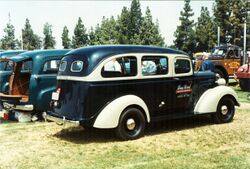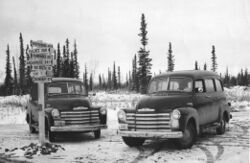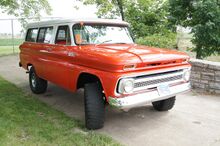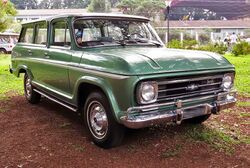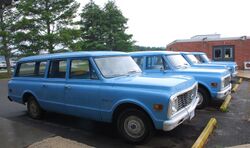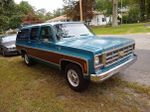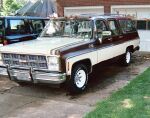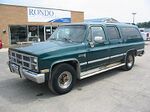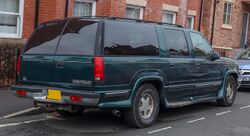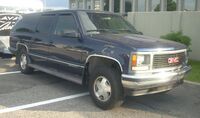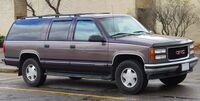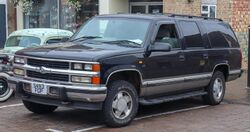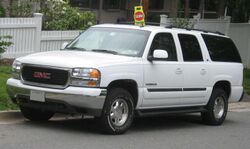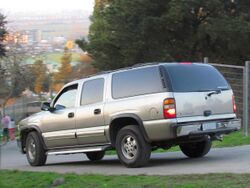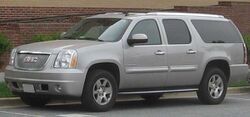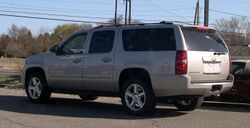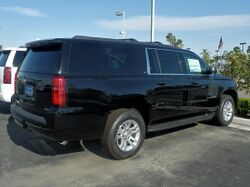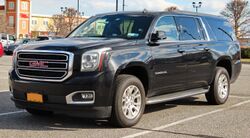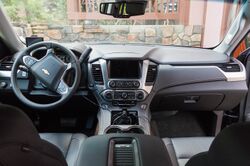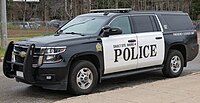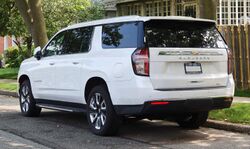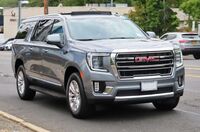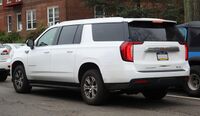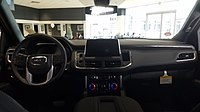Chevrolet Suburban
Topic: Engineering
 From HandWiki - Reading time: 66 min
From HandWiki - Reading time: 66 min
| Chevrolet Suburban GMC Yukon XL | |
|---|---|
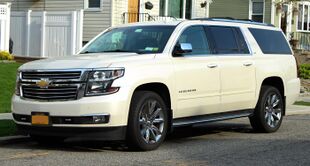 2015 Chevrolet Suburban 1500 LTZ | |
| Overview | |
| Manufacturer | General Motors |
| Also called |
|
| Production |
|
| Body and chassis | |
| Class | Full-size station wagon (1935–1959) Full-size SUV (1960–present) |
| Layout | Front engine, rear-wheel drive / four-wheel drive |
| Related | |
The Chevrolet Suburban is a series of automobiles built by the Chevrolet division of General Motors. In production since the 1935 model year, the model line is currently in its twelfth generation; it is the longest-used automobile nameplate in the world. Beginning life as one of the first metal-bodied station wagons, the Suburban is the progenitor of modern full-size SUVs, combining a station wagon body with the chassis and powertrain of a pickup truck. Alongside its Advance Design, Task Force, and C/K predecessors, the Silverado pickup trucks share chassis and mechanical commonality with the Suburban.
Traditionally one of the most profitable vehicles sold by General Motors,[1] the Suburban has been marketed by both Chevrolet and GMC for nearly its entire history; GMC has used several different nameplates for the model line, marketing the Suburban as the GMC Yukon XL since 2000. Cadillac also rebrands the Suburban as the Cadillac Escalade ESV. During the 1990s, the Holden brand marketed right-hand-drive versions of the model line.
The Suburban is sold in the United States, Canada, Mexico, Central America, Chile, Dominican Republic, Bolivia, Peru, Philippines, and the Middle East (except Israel), while the Yukon XL is sold only in North America (exclusive to the United States, Canada, and Mexico) and the Middle East territories (except Israel).
A 2018 iSeeCars.com study identified the Chevrolet Suburban as the car that is driven the most each year.[2] A 2019 iSeeCars.com study named the Chevrolet Suburban the second-ranked longest-lasting vehicle.[3] In December 2019, the Hollywood Chamber of Commerce unveiled a Hollywood Walk of Fame star for the Suburban, noting that the Suburban had been in "1,750 films and TV shows since 1952."[4][5]
History
Several automotive companies in the United States used the "Suburban" designation to indicate a windowed, station wagon–type body on a commercial frame including DeSoto, Dodge, Plymouth, Studebaker, and Nash, in addition to Chevrolet and GMC. The (Westchester) Suburban name was, in fact, a trademark of U.S. Body and Forging Co. of Tell City, Indiana, which built wooden station wagon bodies for all of these automobile and light truck chassis and more.
Chevrolet began production of its all-steel "carryall-suburban" in 1934.[6] GMC brought out its version in 1937. These vehicles were also known as the "Suburban Carryall" until GM shortened the name to simply "Suburban." GMC's equivalent to the Chevrolet model was originally named "Suburban" as well, until being rebranded as "Yukon XL" for the 2000 model year.
With the end of production of the Plymouth Fury Suburban station wagon in 1978, only General Motors continued to manufacture a vehicle branded as a "Suburban," and GM was awarded an exclusive trademark on the name in 1988. The Chevrolet Suburban is one of the largest SUVs on the market today. It has outlasted competitive vehicles such as the International Harvester Travelall, Jeep Wagoneer, and the Ford Excursion. The latest competitor is the extended-length Ford Expedition EL, which indirectly replaced the Excursion.
The Suburban as of today is a full-size SUV (upgraded to extended-length from 1967 onward to make room for the then-new K5 Blazer that debuted in 1969) with three rows of seating, a full pickup truck frame, and V8 engine. It is one of the few station wagons available with all bench seating rows. The Suburban is the same height and width as the Chevrolet Tahoe, except that the Suburban is 15–20 inches (380–510 mm) longer. The extra length provides a full-sized cargo area behind the nine-passenger seating area.
From 1973 to 2013, it had been available in half-ton and 3/4-ton versions. Chevrolet discontinued this option for the public during the tenth-generation model's tenure after 2013 because of slow sales. However, for the 2016 model year, a one-ton model debuted as an exclusive to rental, fleet, and government services as the eleventh generation in 4WD and with LS and LT trim options, but soft sales would result in Chevrolet discontinuing production on this model after 2019.
In recent years, the Suburban has been used as a police truck, fire chief's vehicle, and EMS vehicle. Suburbans are also used as taxicab livery and limousines. Gothic black Suburban vehicles are commonly used by federal intelligence services, such as the Secret Service. The Secret Service operates fully-armored versions of the Suburban for the President of the United States when he attends less formal engagements.[7] The Suburban (as well as the Tahoe and GMC variants) is very popular with the Federal Bureau of Investigation as a service vehicle.
In the late 1990s, GM also introduced a RHD version of the Suburban, badged as a Holden, for the Australian market. Sales were low and GM withdrew the model in 2000 from Holden's lineup. In 2019, Chevrolet considered bringing the Suburban back to the region as a converted RWD import through Holden Special Vehicles but using the Chevrolet badge, but is holding off on those plans because of numerous factors, including the situation involving GM's decision to retire the Holden brand in 2020.
In 2015, the Suburban commemorated its 80th anniversary at General Motors' Arlington Assembly Plant where the 10 millionth Suburban was produced.[8] A video was posted on Chevrolet's YouTube channel about its eighty-year legacy.[9]
In a February 26, 2018, article celebrating the vehicle's 83rd year, Car and Driver notes that the Suburban's longevity is due to being one of GM's best-selling brands, its appeal to customers across the board regardless of race, gender, class, or political affiliation, and a unique loyalty to the SUV. In an interview from Chevrolet's truck/SUV marketing executive Sandor Piszar, who recalls an event celebrating the truck division's 100th anniversary when they asked about what they named their vehicles, "It's a funny question, but it really is an intriguing point," Piszar says. "People name what they love. And they love their Suburbans."[10]
On December 5, 2019, the Chevrolet Suburban became the first vehicle to be awarded a star on the Hollywood Walk of Fame by the Hollywood Chamber of Commerce for its excellence in film and television, having appeared in more than 1,750 films and television series since 1952, and can also claim to have appeared in at least one television series every year since 1956, and at least one film every year since 1960, the most ever for an automobile of any type. The star, placed at the corner of Hollywood Boulevard and Highland Avenue, also carried the Chevrolet "Bowtie" symbol instead of the entertainment symbols (film, stage, television, radio, musical instruments, and recording artist), another first for the Walk of Fame.[11]
There have been a total of twelve generations of Chevrolet Suburbans since its 1934 debut.
First generation (1935)
| 1935–1940[12] | |
|---|---|
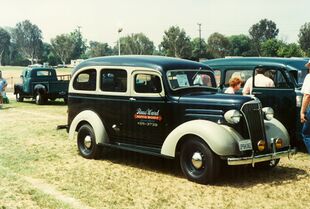 1937 Chevrolet Carryall Suburban | |
| Overview | |
| Model years | 1935–1940 |
| Assembly |
|
| Body and chassis | |
| Body style |
|
| Layout | FR layout |
| Related | Chevrolet Master |
| Powertrain | |
| Engine | 207 cu in (3.4 L) OHV Chevrolet Stovebolt 6 cylinder[14] |
| Dimensions | |
| Wheelbase | 113.5 in (2,883 mm)[15] |
| |uk|Kerb|Curb}} weight | 3,300 lb (1,500 kg) |
Prior to the first-generation Suburban, in 1933, the Chevrolet Master had offered a station wagon body built on the 1/2-ton truck frame. This model was specifically built for National Guard and Civilian Conservation Corps units. Much of the body was constructed from wood and could seat up to eight occupants.
The actual first-generation model was offered by Chevrolet as a "Carryall Suburban" – a utility vehicle featuring a station wagon body on the chassis of a small truck. Focused on functionality, the concept was indeed to "carry all": the whole family and their gear were to find sufficient space in one truck.[6] It shared the front sheet metal and frames of the half-ton pickup models of the same year, but featured all-metal wagon bodies differing very little in shape from contemporary "woodie" station wagons.
Seating for up to eight occupants was available, with three in the front row, two in the middle row, and three in the rear row. Either the side-hinged rear panel doors or a rear tailgate/lift window could be selected for cargo area access while only having two doors for passenger access.[6]
Second generation (1941)
| 1941–1942, 1946 | |
|---|---|
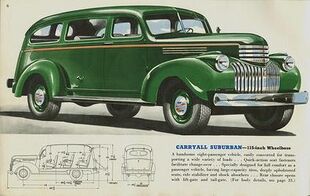 1941 Chevrolet Carryall Suburban | |
| Overview | |
| Model years | 1941–1942, 1946 |
| Assembly |
|
| Body and chassis | |
| Body style |
|
| Layout | FR layout |
| Platform | AK Series |
| Powertrain | |
| Engine | |
| Transmission | 3-speed manual[17] |
| Dimensions | |
| Wheelbase | 116 in (2,946 mm) |
| Length | 196.625 in (4,994 mm)[17] |
Suburbans were built in model years 1941, 1942, and 1946. It was also produced during World War II as a military transport vehicle.[18][15] Seating for up to eight occupants was available. Models with rear panel doors were designated "3106," while those with tailgates were designated "3116." The Chevrolet versions were equipped a 216-cubic-inch 6-cylinder engine. The GMC version was equipped with a 228-cubic-inch 6-cylinder engine. It shared much of its mechanicals with the AK Series trucks.
Third generation (1947)
| 1947–1955 | |
|---|---|
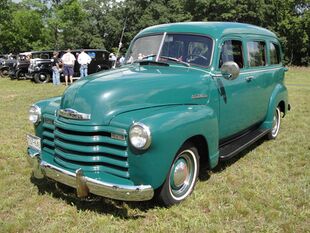 1952 Chevrolet Suburban | |
| Overview | |
| Model years | 1947–1955 (First Series)[19] |
| Assembly | Baltimore Assembly, Baltimore, Maryland[20] Janesville Assembly, Janesville, Wisconsin Leeds Assembly, Leeds, Kansas City, Missouri Norwood Assembly, Norwood, Ohio Oakland Assembly, Oakland, California (Chevrolet & GMC) Pontiac, Michigan (GMC only) St. Louis Truck Assembly, St. Louis, Missouri (Chevrolet & GMC) North Tarrytown Assembly, North Tarrytown, New York Van Nuys Assembly (Van Nuys, California) |
| Body and chassis | |
| Body style |
|
| Layout | FR layout |
| Platform | Advance Design |
| Powertrain | |
| Engine | |
| Transmission | |
| Dimensions | |
| Wheelbase | 116 in (2,946 mm)[21] |
| Length | 196.375 in (4,988 mm) |
This model generation was based on the Chevrolet Advance Design series of pickups.
Beginning in 1953, the Hydra-Matic 4-speed automatic transmission was available in GMC models and in the 1954 model year Chevrolet Suburbans. Models with rear panel doors were designated "3106," while those with tailgates were designated "3116." In 1952, the Suburban came with either a tailgate or panel doors.[15] The front bench seat was split, with two seats on the driver's side and a single seat on the passenger side, which slid forward for access to the rear two rows of seats. The second row was a "2/3" seat, requiring occupants to move past the front passenger seat, as well as the second-row seats to access the third row.
This was the last series to feature "canopy express" models.[22]
The design of the 1947 Suburban would inspire the design of the Chevrolet HHR over half a century later.[23]
Fourth generation (1955)
| 1955–1959 | |
|---|---|
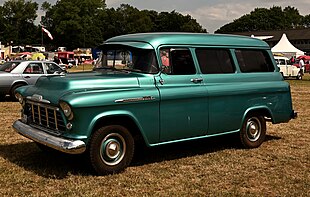 1955-1959 Chevrolet Suburban | |
| Overview | |
| Model years | 1955 (Second Series)[24]–1959 |
| Assembly | Baltimore Assembly, Baltimore, Maryland Janesville Assembly, Janesville, Wisconsin Lakewood Assembly, Lakewood Heights, Atlanta, Georgia Leeds Assembly, Leeds, Kansas City, Missouri Norwood Assembly, Norwood, Ohio Oakland Assembly, Oakland, California (Chevrolet & GMC) Pontiac, Michigan (GMC only) Van Nuys Assembly, (Van Nuys, California) Willow Run Assembly, Ypsilanti, Michigan (1958–1959) |
| Body and chassis | |
| Body style |
|
| Layout | Front engine, rear-wheel drive / four-wheel drive |
| Platform | Task Force |
| Powertrain | |
| Engine | |
| Transmission | 3-speed manual, 4-speed manual, 4-speed Hydra-Matic automatic[27] |
| Dimensions | |
| Wheelbase | 114 in (2,896 mm)[28] |
Updated engineering and styling on Chevrolet trucks was not introduced until March 25, 1955, in the middle of the model year that GM called the Chevrolet Task Force/GMC Blue Chip series. All Chevrolet and GMC truck models received new styling that included a flatter hood, front fenders flush with the body, and a trapezoid grille.[15] The trucks' V-shaped speedometer was shared with passenger car models.[29]
Engines included I6 and the small-block V8s. Chevrolet used its 265 V8 engine, later evolving it to a 283-cubic-inch version. GMC based their V8 on a Pontiac design. Standard Suburban model numbers continued from the previous series, but the introduction of four-wheel-drive models in 1957 added the numbers "3156" for 4WD Suburbans with panel doors, and "3166" for 4WD Suburbans with tailgates.[30][31]
The "Suburban" name was also used on GM's fancy 2-door GMC 100 series pickup trucks from 1955 to 1959, called the Suburban Pickup, which was similar to the Chevrolet Cameo Carrier, but it was dropped at the same time as Chevy's Cameo in March 1958 when GM released the new all-steel "Fleetside" bed option replacing the Cameo/Suburban Pickup fiberglass bedsides. The Suburban name was never used again on a 1/2 ton pickup after the discontinuance of the Suburban Pickup. Although not documented because of a fire that destroyed the records, the production of Suburban Pickups is understood to be 300 or fewer each model year it was offered from 1955 to 1958.
Fifth generation (1960)
| 1960–1966 | |
|---|---|
 1961 Chevrolet Apache Suburban | |
| Overview | |
| Also called |
|
| Model years |
|
| Assembly | Baltimore Assembly, Baltimore, Maryland Flint Truck Assembly, Flint, Michigan Fremont Assembly, Fremont, California (Chevrolet & GMC) 1963-1966 Janesville Assembly, Janesville, Wisconsin Lakewood Assembly, Lakewood Heights, Atlanta, Georgia Leeds Assembly, Leeds, Kansas City, Missouri Oakland Assembly, Oakland, California (Chevrolet & GMC) 1960-1964 Pontiac West Assembly, Pontiac, Michigan (GMC only) St. Louis Truck Assembly, St. Louis, Missouri North Tarrytown Assembly, North Tarrytown, New York São Caetano do Sul, Brazil (Chevrolet Veraneio) |
| Body and chassis | |
| Body style |
|
| Layout | |
| Platform | C/K series |
| Powertrain | |
| Engine | |
| Transmission | 3-speed synchromesh manual, 4-speed synchromesh, 4-speed Hydra-Matic automatic, Powerglide[32] |
| Dimensions | |
| Wheelbase | 115 in (2,921 mm)[32] |
| Length | 199.5 in (5,067 mm)[32] |
| Width | 79.5 in (2,019 mm) |
The styling of the 1960–1961 model year took cues from the late-1950s Chevrolet vehicles and had large oval ports above the grille. An independent front suspension was new for 1960.[33] The cab featured a "wrap around" windshield, while tailgate and panel door rear openings were available.
From 1962 onwards, the hood styling was more conservative, with hoods that eliminated the large ports. In 1964, the front glass area was updated to a flatter windshield and larger door glass. 1,150 lb (520 kg) of cargo could be carried in the back.[34]
This model series introduced a factory-equipped 4WD ("K") option for the first time. The 2WD ("C") models introduced a torsion bar-based independent front suspension and trailing arm and coil spring rear, but by 1963, returned to a more conventional coil-spring approach.
Engine options included straight-sixes and small-block V8s. A 305 cu in (5.0 L) GMC V6 engine was also available on GMC models. This 305 was actually from GMC's medium-duty truck line. It featured high torque but had notoriously poor fuel economy. Transmissions were a 3-speed and 4-speed manual, the automatic Powerglide, and in the GMC models, the dual-range Hydra-Matic from 1960 to 1962.
A 15-passenger conversion was done by Stageway of Fort Smith, Arkansas. These modified Suburbans had three doors on the right, a 171 in (4,343 mm) wheelbase, were 273 in (6,934 mm) long, and weighed 6,300 lb (2,858 kg).[15]
One-ton (C-30), 10-foot (3 m) panel truck models were no longer available after 1966.
Chevrolet Veraneio (Brazil)
In 1964, Chevrolet in Brazil introduced a 5-door version of the Suburban called C-1416 (known as Veraneio from 1969 onwards, which is Portuguese for "summertime"). It was based on the contemporary Brazilian Chevrolet C-14. Like the C-14, the C-1416/Veraneio used the instrument cluster from the U.S. C/K series, although the exterior sheet metal layout is exclusive to Brazil. It was initially powered with a Chevrolet 4.2L inline-six based on the pre-1962 "Stovebolt" engines. Later, it used the 250 cu in (4.1 L) engine from Chevrolet's Brazilian mid-size sedan – the Opala. The original version of the Veraneio was kept in production, with another grille and interior, until 1988 (model year 1989), but it was eventually replaced with an updated version based on the Série 20 family.[35] The second generation of Veraneio was produced from 1989 to 1995.
In 1997, GM introduced the then-current North American pickups to the Brazilian market, replacing the long running C-series. The Brazilian version of the Suburban was also converted to the current generation at the time and lasted until 2001 as the "Grand Blazer", succeeding the Veraneio. The 4.1L inline-six engine with 138 hp (101 kW) was offered on both models with option for a MWM 4.2L turbodiesel unit with 168 hp (124 kW).
In 2015, Autoweek ranked the Veraneio fourth among Chevrolet station wagons never sold in the U.S. It also cited the vehicle's design as "baroque" and summed it up as "a 1960s Brazilian crossover." Autoweek noted that the Veraneio is eligible for import to the United States under the 25-year exemption.[36]
Sixth generation (1967)
| 1967–1972 | |
|---|---|
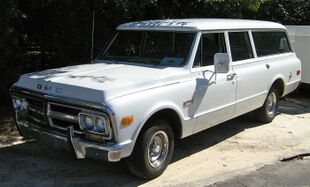 | |
| Overview | |
| Also called | GMC Carryall |
| Model years | 1967–1972 |
| Assembly | Flint Truck Assembly, Flint, Michigan Fremont Assembly, Fremont, California St. Louis Truck Assembly, St. Louis, Missouri Oshawa Truck Assembly, Oshawa, Ontario, Canada |
| Body and chassis | |
| Body style |
|
| Layout | |
| Platform | C/K series |
| Powertrain | |
| Engine |
|
| Transmission | 3-speed manual, 4-speed manual, Powerglide, Turbo-Hydramatic[38] |
| Dimensions | |
| Wheelbase | 127 in (3,226 mm)[15][39] |
| Length | 215.5 in (5,474 mm)[39] |
| Chronology | |
| Successor | Chevrolet Van (for panel truck models) |
The sixth-generation Suburban debuted alongside the "Action-Line" generation of C/K trucks. Growing in size over its International Travelall rival, the Suburban moved from a 115-inch to a 127-inch wheelbase (shared by pickup trucks with 8-foot beds). In another change, a 3⁄4-ton C-20 Suburban was introduced for the first time. Alongside the standard rear-wheel-drive configuration, 4×4 K-10/K-20 models were also offered.
In a configuration distinct to this generation, Action-Line Suburbans are configured with a single driver-side door and two passenger doors. For 1969, the Suburban was joined by the shorter K5 Blazer (GMC Jimmy), a two-door utility vehicle with a lift-off hardtop.
The rear-wheel-drive Suburban was also available as a panel truck for commercial purposes. Following the 1970 model year, the configuration was retired, with the model functionally replaced by the G-Series Chevrolet Van/GMC Vandura for 1971.
Through its production, the Action-Line Suburban shared a large amount of mechanical commonality with its pickup-truck counterpart, sharing the same powertrain offerings. A 250-cubic-inch inline-6 was standard, with a 292-cubic-inch inline-6 offered as an option. Small-block V8s initially were 283 and 327 V8s (later 307 and 350 V8s); a 396 (402) V8 served as a large-block V8 offering. GMC Suburbans were fitted with a 305 V6 as a standard engine until 1970.
Sharing the styling revisions of Action-Line pickup trucks, the Suburban introduced front disc brakes for 1971.[40] Automatic-transmission vehicles received an optional tilting steering column.[41] For 1972, the optional rear-seat air conditioning was redesigned with a smaller housing (previously fitted with a housing that ran the full length of the roof).
The Action-Line Suburban was produced alongside the rapid growth of the recreational vehicle market in the late 1960s. While only about 6,200 Suburbans were produced for 1967, by 1972, production had grown to approximately 27,000.[citation needed] Alongside the retirement of the panel truck configuration, this generation marked the final use of the GMC Carryall name.
Seventh generation (1973)
| 1973–1991 | |
|---|---|
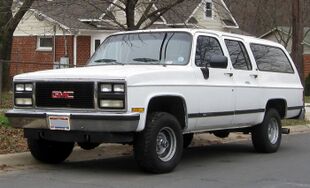 | |
| Overview | |
| Also called |
|
| Model years | 1973–1991 (1989–1996 in Brazil) |
| Assembly |
|
| Body and chassis | |
| Body style |
|
| Layout | |
| Platform | C/K series |
| Related |
|
| Powertrain | |
| Engine |
|
| Transmission | |
| Dimensions | |
| Wheelbase | 129.5 in (3,289 mm) |
| Length | 219.1 in (5,565 mm) |
| Width | 79.6 in (2,022 mm) |
| Height |
|
| |uk|Kerb|Curb}} weight | 5,837 lb (2,648 kg) |
For 1973, the Suburban became part of the Rounded-Line C/K series, with both the Chevrolet and GMC divisions adopting the Suburban nameplate. Growing nominally in size over its Action-Line predecessor, the seventh-generation Suburban completely abandoned its carryall past, introducing a station wagon–style body with four full passenger doors (more than a decade after its Wagoneer and Travelall rivals). As the term "sport-utility vehicle" was more closely associated with off-road vehicles (such as the K5 Blazer), GM designated the Suburban as a truck-based station wagon.[42][43]
From the rear of the passenger doors, the Suburban shared its bodywork (both its doors and roofline) with the C/K crew-cab pickup (a new configuration introduced for 1973). The 1⁄2-ton and 3⁄4-ton 10 and 20 payload series made their return alongside the rear-wheel-drive C-series and 4×4 K-series. Alongside the long-running twin-panel rear doors, the Suburban adopted an optional tailgate-style rear door with a retractable rear window (lowered manually or electrically).[42][44]
Initially offered in Custom, Custom Deluxe, and Cheyenne Super trims,[45] the Chevrolet Suburban adopted a base Custom Deluxe, mid-level Scottsdale, and flagship Silverado trim nomenclature for 1975. GMC Suburbans were initially Custom, Super Custom, and Sierra Grande;[46] in 1975, Sierra Classic replaced Super Custom.[47] In 1981, GMC replaced Custom with Sierra.[48] A rare variant for both Chevrolet and GMC was the Estate option package, offering woodgrain exterior trim (in line with sedan-based wagons); the option was offered through the 1979 model year.[49]
Though technically fitted with only with a front bench seat as standard equipment, the Suburban was offered in multiple interior configurations, offering up to nine-passenger seating. Bucket front seats became a front-seat option in 1978, with the third-row seat changed to a quick-release design (without tools) for 1979.[50]
The Rounded-Line Suburban shared the same exterior revisions of its pickup-truck counterpart. Along with minor revisions in 1975, 1977, and 1980, the model line underwent a more substantial revision in 1981, followed by updates in 1983 and 1985.[51]
Powertrain details
The Suburban shared several engines with the C/K pickup truck line. A 250-cubic-inch inline-six was the standard engine through 1979. The model line was offered with a 307- (1973 only) and 350-cubic-inch small-block V8s; a 454-cubic-inch big-block V8 was optional in C-series Suburbans. For 1976, the 350 V8 was joined by 305- and 400-cubic-inch V8s; the latter was discontinued for 1981. For 1980, V8 engines became standard for the model line, with the 305 returning as the standard engine for 1981. For 1982, GM introduced a 6.2L Detroit Diesel V8 as a higher-efficiency alternative to the 454 V8.[52]
A 3-speed manual transmission was offered through the 1980 model year, with a 4-speed manual offered through 1987. Initially offered with 3-speed Turbo Hydra-Matic 350 and 400 automatic transmissions, a 4-speed Turbo Hydra-Matic 700R4 became an option in 1981.
For 1980, K-series Suburbans moved from full-time four-wheel drive to a part-time system, allowing the front axle to freewheel.[53] For 1981, the shift-on-the fly 4×4 system adopted automatic-locking front hubs; the NP208 transfer case replaced the NP205 in most examples.[54][55]
R/V series (1987–1991)
For 1987, GM redesignated the Rounded-Line C/K series as the R/V series to accommodate the launch of the 1988 GMT400-platform C/K trucks, which were being launched in the spring of 1987. For 1987, the gasoline engines of the model converted from carbureted fuel delivery to electronic fuel injection (using throttle body injection/TBI). For 1988, the 5.0L engine was dropped from the line, with the 5.7L V8 becoming the standard engine. In a trim revision, the R/V line adopted the nomenclature of its GMT400 successor, with all vehicles adopting the 1500/2500/3500 payload series (previously used by GMC) and the base Custom Deluxe trim retired and replaced by a revived Cheyenne trim.
For 1989, the exterior underwent its largest revision since its 1973 introduction. Adopting a style similar to the GMT400, the black-painted grille was offered with quad headlights (economy trims were equipped with two). After using the same design nearly unchanged since 1973, the steering wheel was replaced (adopting the same design as the GMT400).[53]
For 1990, the Suburban introduced power-operated sideview mirrors, also adding the option of rear-wheel ABS. Alongside the Suburban and Blazer/Jimmy, the R/V line was pared down nearly exclusively to 1-ton crew-cab pickup and chassis-cab trucks.
For 1991, the 4-speed 700R4 automatic transmission was replaced by the electronically-controlled 4L80-E unit. After an 18-year production run, the Rounded-Line Suburban ended production as GM shifted crew-cab pickup trucks and full-size SUVs to the GMT400 platform for 1992.
Eighth generation (1992)
| GMT400 | |
|---|---|
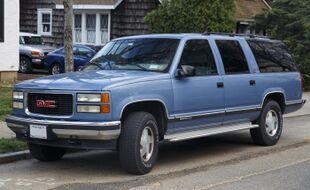 1995 GMC Suburban | |
| Overview | |
| Also called |
|
| Production |
|
| Model years |
|
| Assembly |
|
| Designer | Chuck Jordan (1988) |
| Body and chassis | |
| Body style | 4-door SUV |
| Layout | |
| Platform | GMT410/425 |
| Related |
|
| Powertrain | |
| Engine | |
| Transmission | 4-speed 4L60 automatic (1500 5.7L) 4-speed 4L80 automatic (diesel and 2500) |
| Dimensions | |
| Wheelbase | 131.5 in (3,340 mm) |
| Length |
|
| Width | 77.0 in (1,956 mm) |
| Height | 68.8 in (1,748 mm) (1992–94 1500 2WD) – 74.6 in (1,895 mm) (1997–99 2500 4WD) |
| Chronology | |
| Successor | GMC Yukon XL (for GMC Suburban) |
The GMT400-based Suburbans were introduced in December 1991 for the 1992 model year. The C/K pickup had already switched to the newer platform in 1987 for the 1988 model year. Both 2WD and 4WD models—designated "C" and "K"—were offered, as well as half-ton and three-quarter-ton ("1500" and "2500") models.
The base engine for all variants was the small-block 5.7-liter V8. The big-block 7.4-liter V8 was optional for the 2500 series. The optional 6.5-liter turbo diesel was available for 1994 on 2500 models and from 1995 to 1999 on all models, though rare on the 1500 series. 1500 Suburbans with the 6.5-liter turbo diesel were based on the 2500 series, sharing several mechanical components including the frame, 14-bolt axle, and eight-bolt wheels wearing LT-rated tires. However, their GVWRs were derated from 8600 lbs to 7700 lbs (on 2WD models) and 8050 lbs (on 4WD models). Ground clearance was 6.9 inches (175 mm), the approach angle was 18 degrees for the K1500 (28 degrees for the K2500), and the break-over angle was 18 degrees.[56]
Transmissions included the 4L60 four-speed automatic in the 1500 series, and the heavier-duty 4L80 four-speed automatic in the 2500 series and the 1500 series fitted with the 6.5-liter turbo diesel. The manual transmission option from the previous generation was dropped.
The GMT400 series introduced an independent front suspension. The 2WD models used coil springs and 4WD models used torsion bars in the front suspension. All models used a live axle and leaf springs in the rear.
The 0–60 mph (0–97 km/h) time for a 1995 Suburban with the 5.7L engine was 9.3 seconds. The top speed was governed on the engine for fuel economy. A maximum of 98 mph (158 km/h) could be obtained.[56] City fuel economy was 13 mpg‑US (18 L/100 km; 16 mpg‑imp)[56] and highway was 15 mpg‑US (16 L/100 km; 18 mpg‑imp)[56] while the turning circle was 47.8 ft (14.6 m).[56] For 1996, fuel economy had improved to 17 mpg‑US (14 L/100 km; 20 mpg‑imp) highway.[57]
Trim options included a base-level version, the LS, and the LT (the latter two were originally the "Silverado" trim). Interior seating arrangements allowed for either bucket or bench seating in the first row and optional third-row bench. The vehicle could be configured from two- to nine-passenger seating.
Beginning in 1994, GM began making numerous annual changes to the Suburban, including:
- Revised front clip and center stop lamp (1994)
- Revised interior including a driver-side air bag, revised side mirrors, Silverado trim split into LS and LT (1995)
- Revised 454 cu in (7.4 L) Vortec 5700 and 454 cu in (7.4 L) Vortec 7400 engines with increased power and fuel efficiency, electronic 4WD shifting, daytime running lights, illuminated entry, and some new interior features (1996)
- Revised transmissions, improved steering system, and added passenger-side airbag (1997)
- OnStar, PassLock security system and full-time AutoTrac 4WD option added, next-generation "depowered" air bags, revised steering wheel, transmissions revised again (1998)[58]
- No major changes upon introduction of redesigned 2000 models (1999)
Holden Suburban
In Australia and New Zealand, Holden imported the right-hand-drive Chevrolet Suburban built by GM in Silao, Mexico, between February 1998 and January 2001.[59] The Suburban was first previewed in October 1997 at the Sydney Motor Show.[60] In total, 746 were sold (460 petrol and 286 diesel).[61] After 2001, subsequent models reverted to the original Chevrolet brand, which had also been used before 1998. Over the model's lifetime there were three trim levels: a base model, the LS and the LT. Not to be confused with the trim variants is the model code, designated K8.[62]
The Holden's interior differed from that of the American version, as the right-hand drive dashboard of the Blazer was used instead. However, it had to be stretched on the passenger (left) side to fit in the larger Suburban. A bench seat came standard on the entry-level variant as well as the LS, but the more expensive LT received bucket seats. With the omission of the center seat, the LT has a maximum seating capacity of eight, compared to nine.[63]
Creature comforts standard in all models included a LCD compass in the rear-view mirror, a tilt adjustable steering wheel, a driver's airbag, ABS brakes, and dual-zone air conditioning.[63] The second tier LS brought alloy wheels, power windows and mirrors among some features. To further up the ante, the LT gained electric front seats, leather trim, and a horizontally slated, two-part tailgate. This came as opposed to the "barn doors" found on the other specifications.[64]
The Suburban was offered with the choice of either a 5.7-liter Vortec V8, producing 190 kW (255 hp; 258 PS) and 447 N⋅m (330 lb⋅ft; 46 kg⋅m) of torque, or a 6.5-liter turbodiesel V8 outputting 145 kW (194 hp; 197 PS) and 583 N⋅m (430 lb⋅ft; 59 kg⋅m).[63] The former choice was designated the "1500" name, while the turbodiesel saw the "2500" name.[64] The 5.7-liter petrol engine is LPG-compatible, and such systems can be retrofitted if desired. Regardless of the engine specified, the truck was equipped with a four-speed automatic transmission. However, what differed was the type of transmission. Petrol motors were fitted with the GM 4L60-E transmission, with the GM 4L80-E reserved for the diesel.[61] A dashboard switch allows the vehicle to power all four wheels simultaneously, or the rear wheels only, and allows the low range gearing to be engaged.[63]
The vehicle's fuel efficiency has been rated at 19.7 L/100 km (14.3 mpg‑imp; 11.9 mpg‑US) for the diesel specification,[65] with that figure rising to 21.8 L/100 km (13.0 mpg‑imp; 10.8 mpg‑US) for the petrol model.[66] With the hefty fuel consumption comes a 159-litre (35 imp gal; 42 US gal) fuel tank.[63]
To combat the extra payload and towing capacity of the diesel, an improved braking package, as well as super heavy duty axles and suspension were fitted. Holden recommends a maximum 3,400 kilograms (7,500 lb) towing limit for the turbo diesels, with a reduced figure of 2,720 kilograms (6,000 lb) for the petrol models.[63]
The Holden Suburban's run wasn't the first or only time that Holden had sold the GMT400 platform in Oceania. Beginning in 1996, they imported GMC C/Ks for ambulance conversions. Unlike the Suburbans, these vehicles were not available to the general public, nor did they bear Holden badging. They also were not built as right-hand-drives from the factory like the Suburban was; the same company that handled the ambulance conversion (Jakab Ambulance in Tamworth) also switched the steering to the other side.
Ninth generation (2000)
| GMT800 | |
|---|---|
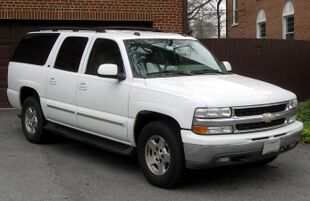 | |
| Overview | |
| Also called |
|
| Production | 1999 – December 2005 |
| Model years | 2000–2006 |
| Assembly |
|
| Designer | Wayne Cherry (1996) |
| Body and chassis | |
| Body style | 4-door SUV |
| Layout | Front engine, rear-wheel drive / four-wheel drive |
| Platform | GMT830 |
| Related | |
| Powertrain | |
| Engine |
|
| Transmission | |
| Dimensions | |
| Wheelbase | 130.0 in (3,302 mm) |
| Length | 219.3 in (5,570 mm) |
| Width | 78.8–79.8 in (2,002–2,027 mm) |
| Height | 73.3 in (1,862 mm) (2000–02 Chevy 1500 4WD) – 77.1 in (1,958 mm) (Yukon XL 2500 4WD) |
The GMT800-based Suburbans were introduced in late December 1999 (Texas-only) and January 2000 (nationally) for the 2000 model year.[68] They were sold in two series: 1/2-ton 1500 and 3/4-ton 2500. Suburbans came in Base, LS, and LT trims. Optional was a push-button 4WD with a low-range transfer case. A tow hitch with a trailer wiring plug was optional.
For 2000, Chevrolet's long-serving 5.7L and 7.4L V8 engines were retired along with the 6.5L diesel (except in Mexico, until 2002). New engines were the LS-based 5.3L Vortec for the 1500 series and 6.0L Vortec for the 2500 series.
Where Chevrolet kept the Tahoe/Suburban branding, GMC renamed its GMT800 products Yukon and Yukon XL, a change that continues to the present day. The shorter 116" wheelbase became the Yukon and the full-length 130" wheelbase became the Yukon XL. Yukons were built in SLE, SLT, and Denali trims.
New features included:
- A spare tire relocated beneath the vehicle (instead of in the cargo area as on previous models)
- "Puddle lamps" in the exterior mirrors on LS and LT models
- Electronic climate control available on LT models
- Four-wheel disc brakes
- Load-leveling Autoride suspension available on LT models
- Premium Ride rear self-leveling suspension available on LS models
- Digital components
- Redesigned wheels
- Redesigned interior with new dashboard and instrument panel including a driver message center and engine hour meter
- Taillights with separate amber-colored turn signal indicators
Yearly changes
- 2001: The 6.0-liter V8 in 2500-series Suburbans gained 20 hp (15 kW; 20 PS) from a number of changes including aluminum cylinder heads. The new Vortec 8100 8.1 L (496 cu in) V8 was added as an option for the 2500 as well. OnStar became standard on LT models and LS models with the new Z71 package. Quadrasteer four-wheel steering was added as an option on 2500 models only.
- 2002: Several optional features were made standard equipment on the LS model, including front and rear air conditioning, alloy wheels, power windows, power front seats, side steps, fog lamps, and heated outside rearview mirrors. Base models were discontinued, leaving LS and LT. The Vortec 5300 L59 variant in the 1500 series added flex-fuel capability.
- 2003: All GM full-size trucks received an upgraded interior, with better-quality materials and other enhancements. New radios offered Radio Data System compatibility, XM satellite radio, Bose sound and improved ergonomics. Adjustable pedals were added as an option, and the instrument cluster-mounted Driver Information Center was improved and monitored up to 34 vehicle functions. A Panasonic DVD system was added as an option. GM's Stabilitrak system was added, and Quadrasteer became available on 2500 series Suburbans. Towing capacity for Quadrasteer-equipped vehicles was reduced by 300 pounds (140 kg) (the weight of the system).[69] Although the pickup trucks received a revised front fascia, it was not carried over to the SUVs (except for Suburban/Tahoe in Mexico only).
- 2004: 1500-series Suburbans received the Hydroboost braking system that was previously introduced in the 2500 series. The Mexican-market Suburban received a front-end update that year, matching that of the Silverado.
- 2005: The long-standard side-hinged panel doors were discontinued in favor of the formerly optional liftgate. All engines switched to electrically driven radiator fans to reduce power loss and fuel consumption. The Z71 package, long exclusive to 4WD models, became available on 2WD Suburbans. OnStar also became standard across the board. Finally, Stabilitrak became standard on all models shortly after the start of the model year. The 2005 Suburban 1500 won the J.D. Power and Associates award for highest initial quality among large SUVs, beating out its rivals the Ford Expedition and Toyota Sequoia.
- 2006: The GMT800 Suburban's last year. A special LTZ trim package became available, featuring 20-inch (510 mm) wheels, all-wheel drive, and the LQ4 6.0L engine from the GMC Yukon Denali. The catalytic converters were relocated closer to the engine. The XM radio antenna and the OnStar antenna were combined into a single unit.
Engines
| Year | Engine | Power | Torque | RPO Code | VIN Code (8th Digit) | Notes |
|---|---|---|---|---|---|---|
| 2000–2003 | 5.3L Vortec 5300 V8 | 285 hp (213 kW) @ 5200 RPM | 325 lb⋅ft (441 N⋅m) @ 4000 RPM | LM7
L59 (flex-fuel) |
T
Z (flex-fuel) |
Power and torque ratings are on regular gasoline.
Flex-fuel option available from 2002 to 2006. |
| 2004–2005 | 295 hp (220 kW) @ 5200 RPM | 330 lb⋅ft (450 N⋅m) @ 4000 RPM | ||||
| 2006 | 295 hp (220 kW) @ 5200 RPM | 335 lb⋅ft (454 N⋅m) @ 4000 RPM | ||||
| 2001–2002 | 6.0L Vortec 6000 V8 | 320 hp (239 kW) @ 5200 RPM | 365 lb⋅ft (495 N⋅m) @ 4000 RPM | LQ4 | U | GMC Yukon Denali and 2006 Suburban LTZ only. |
| 2003 | 320 hp (239 kW) @ 5000 RPM | 365 lb⋅ft (495 N⋅m) @ 4000 RPM | ||||
| 2004 | 325 hp (242 kW) @ 5200 RPM | 365 lb⋅ft (495 N⋅m) @ 4000 RPM | ||||
| 2005–2006 | 335 hp (250 kW) @ 5200 RPM | 375 lb⋅ft (508 N⋅m) @ 4000 RPM | ||||
| 2000 | 6.0L Vortec 6000 V8 | 300 hp (224 kW) @ 5000 RPM | 355 lb⋅ft (481 N⋅m) @ 4000 RPM | LQ4 | U | 2500 only.
2000 models used cast-iron heads. |
| 2001–2003 | 320 hp (239 kW) @ 5000 RPM | 360 lb⋅ft (490 N⋅m) @ 4000 RPM | ||||
| 2004 | 325 hp (242 kW) @ 4000 RPM | 369 lb⋅ft (500 N⋅m) @ 4000 RPM | ||||
| 2005 | 325 hp (242 kW) @ 5200 RPM | 365 lb⋅ft (495 N⋅m) @ 4000 RPM | ||||
| 2006 | 335 hp (250 kW) @ 5200 RPM | 375 lb⋅ft (508 N⋅m) @ 4000 RPM | ||||
| 2001–2003 | 8.1L Vortec 8100 V8 | 340 hp (254 kW) @ 4200 RPM | 455 lb⋅ft (617 N⋅m) @ 3200 RPM | L18 | G | 2500 only. |
| 2004 | 320 hp (239 kW) @ 4200 RPM | 445 lb⋅ft (603 N⋅m) @ 3200 RPM | ||||
| 2005 | 320 hp (239 kW) @ 4200 RPM | 440 lb⋅ft (600 N⋅m) @ 3200 RPM | ||||
| 2006 | 325 hp (242 kW) @ 4200 RPM | 447 lb⋅ft (606 N⋅m) @ 3200 RPM |
In addition, a Vortec 5700 350 cu in (5.7 L) V8 remained in use in 2000–2002 Suburbans, Tahoes (called Sonora), and Silverado pickup trucks in the Mexican market.
Tenth generation (2007)
| GMT900 | |
|---|---|
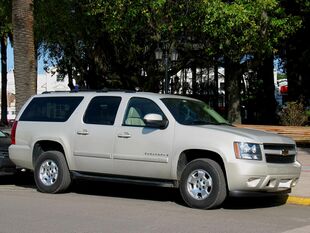 | |
| Overview | |
| Also called |
|
| Production | January 2006 – December 2013 |
| Model years | 2007–2014 |
| Assembly |
|
| Designer | Wayne Cherry (2002) |
| Body and chassis | |
| Body style | 4-door SUV |
| Layout | |
| Platform |
|
| Related | |
| Powertrain | |
| Engine |
|
| Transmission | |
| Dimensions | |
| Wheelbase | 130.0 in (3,302 mm)[70] |
| Length | 222.4 in (5,649 mm)[70] |
| Width | 79.1 in (2,009 mm) |
| Height |
|
| |uk|Kerb|Curb}} weight | 2,540–2,857 kg (5,600–6,299 lb)[71] |
The 2007 model year Suburban and Yukon XL were unveiled at the 2006 Los Angeles Auto Show in January. Production of the redesigned GMT900 Suburban and Yukon XL began at Janesville Assembly and Silao Assembly in January 2006 (Suburban) April 2006 (Yukon XL), with the vehicles arriving at dealerships in April 2006.
The new models were redesigned with more modern and rounded styling,[70] already seen on the previously released 2007 Tahoes and Yukons. For the first time, the SUVs did not share any exterior parts with the pickup trucks except for the doors. The exterior features a more aerodynamic shape, made partly by a steeply raked windshield angle.
The interior had a redesigned dashboard and improved seats. It still retained its 9-passenger seating availability, which was available on LS and SLE models only. LT2 and LT3 models have leather seating and available 6-, 7-, and 8-passenger seating. A Z71 package was available on LT2 and LT3 models which included two-tone leather seats. All Mexican-built Suburbans including the 9-seat models offered the special two-tone leather seating used by the Z71. The Suburban LTZ came standard with a DVD player and a GPS-enhanced touchscreen radio.
For the 2010 model year, in which U.S. News & World Report ranked it as the number-one affordable large SUV,[72] the Suburban added a premium interior package that included tri-zone climate control and handy features like Bluetooth and rear audio controls. Additionally, radios added a USB port, allowing for music to be played from auxiliary devices through the radio, as well as charging other small electronics. Side blind zone alert became an option on LT and standard on LTZ. The 6.0-liter engine in the 2010 models was also flex-fuel capable. Minor front-end changes including a slightly raised front bumper and side torso airbags were also made standard for 2010.
In February 2010, Chevrolet unveiled a 75th-anniversary edition of the Suburban, which had the LTZ trim with white diamond tricoat exterior paint and cashmere interior, along with standard 20-inch chrome-clad wheels, revised roof rails, integrated navigation radio, XM Satellite Radio, Bluetooth phone connectivity, rearview camera, rear park assist, remote starting, adjustable pedals, and leather upholstery with heated/cooled front seats. According to Chevrolet, only 2,570 units of this special edition would be produced because of the amount of white diamond paint GM could procure.[73]
The 5.3-liter and 6.0-liter engines were improved, and a new 403-horsepower (301 kW; 409 PS) 6.2-liter Vortec V8 was added for the Yukon XL Denali. The 8.1-liter engine was dropped.
For the 2011 model year, the Suburban added three new exterior colors to the lineup: Mocha Steel Metallic, Green Steel Metallic, and Ice Blue Metallic. More features became standard on each trim, with the rear audio system, Bluetooth, floor console/storage area, woodgrain interior, luggage rack rails, body-color exterior door handle/mirror caps, and premium-cloth front bucket seats now standard on the LS trim, and chrome recovery hooks, two-speed transfer case, and 20-inch chrome wheels standard on LTZ 4WD models. In addition, the trailering package featured the trailer brake controller as standard on all trims.[74]
For the 2012 model year, trailer sway control and Hill Start Assist become standard on all trims, while the LTZ trim added a heated steering wheel as standard.[75] Also, the LT1/2 options for the Suburban and SLE1/2 and SLT1/2 options on the Yukon XL were discontinued, leaving the Suburban with only an LS, LT, and LTZ trim and the Yukon XL with an SLE and SLT trim. In 2012, GMC celebrated its 100th anniversary by releasing a special edition of its Yukon XL, offering a Heritage Edition trim package.[76] This was the final year that three colors, Graystone Metallic, Gold Mist Metallic, and Blue Topaz Metallic, would be offered, along with the all-season blackwall P265/65R18 tires.
For the 2013 model year, two new colors were offered: Champagne Silver Metallic and Blue Ray Metallic (extra charge). Also new was Powertrain Grade Braking, normal mode. The 2013 model arrived at Chevrolet dealers in June 2012.[77]
For the 2014 model year, power-adjustable pedals, remote vehicle starter system, and rear parking assist along with rear vision camera and inside mirror with camera display became standard on the Suburban LS trims. Concord Metallic (which was supposed to be available for the 2013 MY) was added to the Suburban color offerings for the 2014 models.[78] For the Yukon XL, a convenience package became standard on its SLE models, along with a new color, Deep Indigo Metallic.[79] In February 2014, The Suburban came in second behind the Tahoe among the top-ranked large affordable SUVs by U.S News & World Report.[80] This would be followed by being acknowledged as an award recipient in the large SUV category by JD Power and Associates in July 2014.[81]
The three-quarter-ton model's towing capacity is 9,600 lb (4,400 kg), being one of the best of any 4×4 SUV and unmatched by any other SUV. The towing capacity of the Suburban 2500 was unmatched, but also uncontested because of the discontinuation of the Ford Excursion in 2006. The three-quarter-ton model also has a GCVW of 16,000 lb (7,300 kg).
The 2500 Suburban was originally sourced from Silao, Mexico, from 2007 to 2008 but was moved to the Arlington, Texas, assembly plant for the 2009 model year, where production of all GM fullsize SUVs was consolidated after the closing of the Janesville plant.[82][83]
GM discontinued the 2500 versions of both Suburban and Yukon XL models after the 2013 model year.[84][85]
Eleventh generation (2015)
| GMT K2YC/G | |
|---|---|
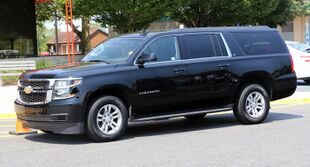 | |
| Overview | |
| Also called |
|
| Production | December 2013–December 2019 |
| Model years | 2015–2020 |
| Assembly | Arlington, Texas, U.S. (Arlington Assembly) |
| Designer | Louis "Chip" Thole, Warrack Leach, Alexandre Henriques, Tyler Moffatt, Fawad Jamil[86] |
| Body and chassis | |
| Layout | |
| Platform |
|
| Related | |
| Powertrain | |
| Engine |
|
| Transmission |
|
| Dimensions | |
| Wheelbase | 130.0 in (3,302 mm) |
| Length |
|
| Width | 80.5 in (2,045 mm) |
| Height |
|
| |uk|Kerb|Curb}} weight | 5,586–6,021 pounds (2,534–2,731 kg)[88][89] |
The eleventh generation Chevrolet Suburban, GMC Yukon XL, and Yukon Denali XL were introduced to the public on September 12, 2013,[90] and GM unveiled the vehicles in different locations (the Suburban in New York, Yukon XL in Los Angeles) on that date.[91] Both vehicles are based on the GMT K2XX platform and carried specific model numbers, identified by platform (K2), brand (YC for Chevrolet, YG for GMC), drivetrain (C for 2WD; K for 4WD), tonnage (15 for half-ton, 25 for 3/4-ton, 35 for 1-ton), wheelbase (7 for short, 9 for long), and 06 for SUV, which means that a K2YC-K-15-9-06 would be identified as a Chevrolet Suburban 1500 4WD.[92] The Suburban and Yukon XL went on sale in February 2014 as a 2015 model,[93][94] with the vehicles built exclusively in Arlington, Texas.[95]
Production details
The newly redesigned Suburban and Yukon XL were showcased to the public for the first time on September 27, 2013, at the State Fair of Texas.[96][97] This move comes on the heels of the 80th anniversary of the first production of the Suburban in 1934.
The designs and concepts were created by GM's exterior design manager Chip Thole (before his transfer to GM's Buick design studio in 2013), who told Truck Trend "I start with what intuition tells me about the market and get the team going on that. You look at trends around the industry – fashion, culture, what people are buying, what they say they want now – and project that into the future. The fun part is putting those ideas to paper and going from there." He then added, "We wanted to take what was good about today's vehicles, bring that forward and make them new and different with that spark of freshness that people recognize, without making them gimmicky or overdone." Thole also challenged his design team to help bring ideas to the SUVs, which lead to the split headlamps and a more graphic feel for the Suburban design, while a more industrial but sculptured look was added to the Yukon XL to give it a unique identity of its own.[98]
Production on the Suburban and Tahoe began in December 2013 with the first completed SUVs being used for testing purposes.[99] GM then officially started shipping the vehicles to dealerships on February 5, 2014.[100] It is estimated that it took 8–10 weeks to assemble the SUVs, save for the upgrades on the level trims and destination scheduling.[101]
Features
The front fascia of the Chevy Suburban and GMC Yukon XL is distinct, but from the base of the A-pillars back, they share most of the same styling cues. This now includes inlaid doors that tuck into the door sills, instead of over them, improving aerodynamics, fuel economy, and lessens interior noise. The hoods and liftgate panels are made of aluminum to reduce vehicle weight, and the wiper blades that were located on the liftgate door were moved to the rear spoiler located on the top of the rear liftgate window. Also noticeable is the SUV's length, which expands from 222.4 to 224.4 in (5,649 to 5,700 mm) (the Yukon XL's length is shorter at 224.3 in (5,697 mm)) and its width from 79.1 to 80.5 in (2,009 to 2,045 mm), while the height decreases from 76.8 to 74.4 in (1,951 to 1,890 mm), thus allowing the vehicle to become slightly leaner, a little bit wider, more streamlined, and roomier.
A more efficient, direct-injected EcoTec3 V8 powertrain (5.3 for the Suburban, 6.2 for Yukon XL/Yukon Denali XL) coupled with improved aerodynamics, helped the SUVs offer greater estimated highway fuel economy and improving its fuel economy estimates to 16 mpg‑US (15 L/100 km; 19 mpg‑imp) (city), 23 mpg‑US (10 L/100 km; 28 mpg‑imp) (highway), and 18 mpg‑US (13 L/100 km; 22 mpg‑imp) (combined) for 2WD, and 15 mpg‑US (16 L/100 km; 18 mpg‑imp) (city), 22 mpg‑US (11 L/100 km; 26 mpg‑imp) (highway), and 18 mpg‑US (13 L/100 km; 22 mpg‑imp) (combined) for 4WD.[102] The increased fuel economy also vaulted the Suburban/Yukon XL into the top spot among large SUVs with the most efficient fuel economy rating numbers for this segment.[103] However, when Motor Trend (which placed the 2015 Suburban on the front cover of its June 2014 issue) did a road test review on the SUVs, it estimated the 4WD MPG on the Suburban LTZ to be slightly better at around 15.2 mpg‑US (15.5 L/100 km; 18.3 mpg‑imp) city and 22.3 mpg‑US (10.5 L/100 km; 26.8 mpg‑imp) highway, while the 4WD Yukon Denali XL, whose fuel economy (MPG) is rated at 14 mpg‑US (17 L/100 km; 17 mpg‑imp) city and 20 mpg‑US (12 L/100 km; 24 mpg‑imp) highway, was estimated lower at 12.4 mpg‑US (19.0 L/100 km; 14.9 mpg‑imp) city and 19.2 mpg‑US (12.3 L/100 km; 23.1 mpg‑imp) highway.[104]
Like the 2007–14 version, both the Suburban and Yukon XL did not share a single piece of sheet metal or lighting element with the brands' full-size pickup trucks, and the front grilles of both vehicles were slightly altered to give it their own identity. The front headlights featured projector-beam headlamps flanking the Chevrolet-signature dual-port grille – chrome on all models, sweeping into the front fenders, while the Tahoe/Suburban LTZ and Yukon/XL Denali trims featured projector-beam high-intensity discharge headlamps and LED daytime running lamps. The Yukon and Yukon XL also featured projector-beam halogen headlamps on SLE and SLT trims. The improved safety features included a 360-degree radar detection for crash avoidance and occupant protection and a high-tech anti-theft system that now included vertical and interior sensors, in-glass and window breaking, a triggering alarm, and a shutdown device preventing the vehicle from moving. The latter was expected to address the issues regarding the constant thefts of the vehicles, especially with the previous generation's removable seats and items left in the cargo space, which has become a target for carjackers who see the third-row seats as valuable on the black market.[105] According to General Motors' head of Global Vehicle Security Bill Biondo, "We have engineered a layered approach to vehicle security ... With new standard features and the available theft protection package, we are making the vehicles less attractive target to thieves and more secure for our customers."[106]
Also new were the addition of fold-flat second and third-row seats (replacing the aforementioned removable third seats), which was now a standard feature but could be equipped with an optional power-folding feature for the upgraded trims, and an additional two inches of legroom for second-row passengers. HD radio became a standard feature on all trims. Multiple USB ports and power outlets were now spread throughout their interiors, including one 120 V three-prong outlet on both Suburban and Yukon XL, with the Suburban adding an available eight-inch color touch screen radio with next-generation MyLink connectivity along with an available rear-seat entertainment system with dual screens and Blu-ray DVD player, while the Yukon XL added a standard eight-inch-diagonal color touch screen radio with enhanced IntelliLink and available navigation. A 4G LTE WiFi access system, along with Siri Eyes Free and text messaging alerts, was included in all vehicles featuring the OnStar device around the second quarter of 2014.[107][108]
Suburban HD
With the change to the K2 platform, GM discontinued the 3⁄4-ton Suburban 2500; however, plans were revealed to offer a K2-based Suburban HD for fleet sales according to an updated VIN decoding document filed in March 2015.[109] This version, identified as a Class 3 vehicle (around 10,000 to 14,000 pounds (4,500 to 6,400 kg) GVWR), was only available as a 4WD vehicle with the same design as the eleventh generation (K2XX), but was equipped with a different engine altogether.[109] The Suburban HD was offered only in LS and LT trims, reserving the LTZ trim for a more luxurious offering (like limousine or taxi-related services).[110] It also was not offered with 2WD or upgraded packages. In addition, there were no plans to offer a 3⁄4-ton GMC Yukon XL as GM made the design exclusive to Chevrolet.[109][111]
The Suburban HD was officially named the "Suburban 3500HD," indicating a one-ton truck rating, and was introduced for the 2016 model year. This was available exclusively for fleet sales and equipped with the L96 6.0L V8 engine, 6L90 6-speed heavy-duty automatic transmission (RPO MYD), 17-inch machined aluminum wheels (8-lug), a high-capacity air cleaner, 220-amp alternator, external engine oil cooler, and auxiliary transmission cooler. The 3500HD did not include HD radio.[112] Although the vehicle had a high GVWR of 11,000 lb (5,000 kg), it is intended to provide a larger payload but minimal towing capacity, as it primarily was intended for conversion to an armored transport.[113]
The 2019 model year would be the last year for the K2-based Suburban HD;[113] chassis production ceased in August 2018.[114][115]
2015 mid-year update
The Suburban added a hands-free power liftgate feature that is standard on the LTZ but included on the LT with the optional Luxury Package. The added 4G LTE WiFi and Siri features became standard on both LT and LTZ trims, while the MyLink with Navigation feature was upgraded from optional to standard on the LTZ trim. The E85 capability feature is removed from retail orders.[116]
The Yukon XL's 6.2-liter EcoTec3 V8 engine was updated with the new 8L90E eight-speed automatic transmission for the interim model year, allowing it to improve fuel economy.[117] The Yukon XL Denali, however, saw its MSRP bumped up by $1,300 (~$1.4 thousand in 2019) in part because of the loaded features.[118]
All GM full-sized SUVs received a body-colored painted Shark Fin antenna as part of the 2015 mid-year refresh.
This refresh is often referred to as the 2015i, "i" for interim processing code.
2016
For the 2016 model year (which commenced sales in July 2015), the Chevrolet Suburban received more upgraded changes and new features that included power-adjustable pedals, forward collision alert, IntelliBeam headlamps, lane keep assist, and a safety alert seat as part of the newly introduced enhanced driver alert package as an available option on the LS trim. The inside floor console with storage area-SD card reader was removed, while a new AM/FM audio integrated system with Sirius XM, HD Radio, and CD/MP3 capabilities was introduced as a standard feature on all trims; the 8-inch MyLink feature was expanded to the LS trim and became standard (replacing the 4-inch display), although the navigation feature remained as an option on LT and standard on LTZ. A new liftgate shield was added to the Theft Protection Package, along with the new lane keep assist which replaced the lane departure warning. The capless fuel fill tanks became standard on all trims. Siren Red Tintcoat and Iridescent Pearl Tricoat became the new color trims, replacing Crystal Red Tintcoat and White Diamond Tricoat. The instrument cluster was re-configured with a new multi-color enhancement and a heads-up display was introduced as a standard only on the LTZ trim.[119][120] The 2016 models also saw a price hike as well.[121]
The 2016 GMC Yukon XL also sees similar changes, with the new enhanced driver alert package as an available option on the SLE trim, liftgate, power, hands-free now packaged on SLT trims, a free-flow feature that replaced the Premium package, a lane keep assist added to all trims, and two new premium colors (Crimson Red Tintcoat and White Frost Tricoat) replacing Crystal Red Tintcoat and White Diamond Tricoat respectively.[122][123]
Chevrolet added Apple CarPlay and Android Auto Capability features to the Suburban starting with the 2016 models. However, only one of their phone brands at any one time can be used,[124] while the Android Auto option was only available on LT and LTZ trims featuring 8-inch screens.[125]
GM expanded newer 4G LTE features (like detecting battery failure and monitoring insurance discounts based on driver performance) to 2016 model year vehicles, including the Suburban, which GM cited as being the vehicle that is the most used among data subscribers.[126]
2017
The 2017 model year Chevrolet Suburban received upgraded changes after it went on sale in August 2016. The level trims LS and LT are retained but the LTZ is renamed Premier, the latter serving as the equivalent to the Yukon XL Denali. The LS trims also saw the badged "LS" lettering removed. The new features include two new colors (Blue Velvet Metallic and Pepperdust Metallic), two new 22-inch wheel options (a 7-spoke Silver wheels with Chrome inserts for all trims; Ultra Bright machined aluminum wheels with Bright Silver finish for Premier trim only), black roof rack cross rails (as part of the Texas Edition Package and All-Season Package), front active aero shutters (all trims), and heated and vented seats (Premier trim only). The MyLink was updated to incorporate Teen Driver, App Shop, Rear Seat Reminder customization, and Low-Speed Forward Automatic Braking (as part of Enhanced Driver Alert Package on the LS trim, but standard on LT and Premier). The Rear Seat Entertainment System was overhauled to include a new video voiceover feature for the visually and hearing impaired, an HDMI/MHL connector, digital headphones, Digital Living Network Alliance (DLNA) technology incorporated into the Wi-Fi system, and a second USB port with the capability of charging up to a 2.1-amp at the back of the console.[127][128]
The 2017 model year Yukon XL also received similar changes, but with a few exceptions. Two new colors, Dark Blue Sapphire Metallic and Mineral Metallic were introduced, the latter exclusive to the Denali, which also added a new 22-inch ultra-bright aluminum wheels with midnight silver premium paint and a head-up display to its features. The interior backlights changed from red to blue. The heated and vented driver and front passenger seats became standard on the SLT and Denali trims.[129][130]
2018
The 2018 model year Suburban had a few upgrades and deletions. LED daytime running lights became standard on all trims, along with a new color, Havana Metallic and Satin Steel Metallic. The Cocoa/Mahogany interior that was combined with the Pepperdust Metallic exterior was dropped along with the wireless/inductive phone charging that was part of the Luxury and Texas Edition LT level trims. The fleet/commercial level trim, which had fewer features, was upgraded to include MyLink, HD Radio, multi-color driver information center, LED daytime running lights, and an optional driver alert package.[131]
The 2018 Yukon Denali XL received a new grille with a layered appearance like the ones on its redesigned 2018 Acadia and Terrain brands, featuring high-intensity-discharge headlights and LED daytime running lights. The refreshed design provided better airflow to the radiator, and when less cooling air is needed, shutters behind the grille closed to improve aerodynamics and efficiency. The interior featured new ash wood trim that, according to GMC, gave the cabin a richer appearance. A new 10-speed automatic transmission was mated to its 420-horsepower (313 kW; 426 PS), 6.2-liter V8 engine, replacing the 8-speed transmission.[132]
2019
The 2019 Suburban will have both Havana Metallic and Tungsten Metallic deleted in favor of a new Shadow Gray Metallic exterior color, while the top-of-the-line Premier now had the name displayed on the tailgate. The LS trim continued to make HD Radio a standard feature, but could be deleted if customers opted for the OnStar feature.[133]
The 2019 model year GMC Yukon XL added three new exterior colors, Dark Sky Metallic, Pepperdust Metallic, and Smokey Quartz Metallic, while deleting two others, Mineral Metallic and Iridium Metallic. GMC also introduced two new package features, Graphite Edition and Graphite Performance Edition, which were available in the SLT trim only.[134]
2020
The 2020 Chevrolet Suburban dropped the LT Signature Package and the LS All-Season Package, along with the Pepperdust Metallic color,[135] while the 2020 GMC Yukon XL replaced its Pepperdust Metallic color with Carbon Black Metallic and made no additional changes.[136]
Accolades
The 2015 Suburban was ranked third among the top affordable SUVs and fifth among affordable SUVs with 3-row seats by U.S. News & World Report,[137] and was among the finalists in Motor Trend's SUV of the year for 2015.[138] It also received a 2015 MotorWeek Drivers' Choice Award for best large SUV,[139] while Consumer Reports ranked the Suburban as the best SUV with a third row seat, topping its competitors in this category.[140]
The Chevrolet Suburban took third place behind the Tahoe and GMC Yukon in the 2016 J.D. Power Vehicle Dependability Study among full-size SUVs, based on responses from owners of the vehicles.[141]
Good Housekeeping named the 2018 Suburban the "Best New Car of Year 2018" in the Large SUV category. In its review of the vehicle from GH and its reason for the decision to award the SUV: "Whether you're bringing the whole soccer team home or moving kids into college, it's a larger-than-life workhorse that can handle your crew and all their stuff."[142]
Consumer Reports added the 2018 Suburban to their recommended list due to high owner satisfaction scores.[143]
The Suburban was given a Hollywood Walk of Fame star on December 5, 2019, one of two inanimate objects to be awarded such (Disneyland being the other), for its frequent appearances in film and television. Because city regulations prohibit placing corporate names on public sidewalks including the Walk of Fame, the star was instead placed in an area adjacent to the Walk of Fame.[11]
Sales
The eleventh-generation Suburban saw an increase in sales; April 2014 brought a 109.8 percent spike, with most dealers reporting that the vehicles are being sold within 10 days after arriving on the lot, with customers opting for the fully loaded LTZ model, making it one of Chevrolet's fastest selling brands in 2014.[144] The eleventh generation Suburban is also a hot seller in the Middle East, where in August 2014 posted a 37% increase in sales, with most of the purchases coming from Saudi Arabia (65%), the United Arab Emirates (15%) and Qatar (108%).[145] By the end of September 2014, GM sold more than 4101 units of the Suburban (up 50.1%), while the Yukon XL posted 2165 units sold (up 64%), with GM boasting that 80% of the vehicles sold were its large SUVs.[146]
In Canada, sales of the Suburban reached 966 units (up 43%) in 2014, although the Yukon XL was the best seller in that country with 1,760 vehicles sold (up 50.3%) that same year.[147] Overall, they accounted for 70 percent of GM Canada's SUV sales for 2014.[148]
On August 17, 2015, GM confirmed plans to increase production on its large SUVs, especially on the Suburban/Yukon XL, citing lower gas prices and a higher demand for the vehicles. The move also resulted in its Arlington Assembly adding more hours and increasing its production from 48,000 SUVs to 60,000 based on the expanding hours and added Saturday overtime shifts.[149]
The 2017 MY Suburban saw its biggest sales increase in January 2017, when it posted a 72.3% gain (5,634 units), the most ever since January 2008 when it had the 2008 MY Suburban.[150]
Twelfth generation (2021)
| GMT1YC | |
|---|---|
 | |
| Overview | |
| Also called |
|
| Production | May 2020–present |
| Model years | 2021–present |
| Assembly | Arlington, Texas, U.S. (Arlington Assembly) |
| Body and chassis | |
| Layout | |
| Platform | GMT T1XX |
| Related | |
| Powertrain | |
| Engine |
|
| Transmission | 10-speed Hydra-Matic 10L80 automatic |
| Dimensions | |
| Wheelbase | 134.1 in (3,406 mm) |
| Length |
|
| Width | 81.1 in (2,060 mm) |
| Height | 75.7 in (1,923 mm) |
| |uk|Kerb|Curb}} weight | 5,785–5,993 lb (2,624–2,718 kg) |
On December 10, 2019, Chevrolet introduced the twelfth-generation Suburban at Little Caesars Arena in Detroit, Michigan. This time around, GM chose to introduce the Chevrolet full-size SUVs first. The GMC Yukon XL was later introduced on January 14, 2020.[151] Although the fifth-generation Cadillac Escalade made its debut on February 4, 2020,[152] its extended length sibling Escalade ESV was the last GM full-size SUV to be introduced online in April 2020 after it was withdrawn from the cancelled 2020 New York International Auto Show.[153][154] Originally scheduled to start in April 2020, due to the COVID-19 recession, GM postponed production of the Suburban to May 18, 2020. The Suburban began entering dealerships in June 2020.[155][156]
Chevrolet Suburban
2021
Based on the same GMT T1XX platform as the Silverado 1500, the Suburban distinguished itself by swapping that truck's live axle and leaf springs for an independent rear multilink suspension setup with coil springs, thus lowering the floor of the vehicle and creating more room, in both the cargo area and the second- and third-row seats.[157] The Suburban expanded its length to 225.7 inches (5,733 mm), and the wheelbase to 134.1 inches (3,406 mm) while shortening down by 15 inches (381 mm) longer than the Tahoe (as its wheelbase was moved back by 5 inches (127 mm)), making it the largest and longest SUV in the extended-length segment. It gains two cubic feet (57 L) of cargo space behind the third row and 2.2 inches (56 mm) of third-row legroom. The towing capabilities were increased with the twelfth-generation models.[158]
The trims feature the primary basic LS, LT, and Premier levels, with the 4WD-exclusive Z71 and RST moving from package to premium levels, along with the newly added High Country level, the latter being the top of the line. Chevrolet rolled out the LT, Z71, Premier, and High Country levels first, with the LS and RST levels arriving in late Fall 2020.[159]
Quad exhaust tailpipes are added to the vehicle, giving it a more unique look, although this feature is only standard on Premier and High Country. This feature isn't offered on the LS, LT, Z71 and RST because of their configuration as regular base, off-road, and street-centric level trims respectively, nor on all trims with a Duramax option.[160] The RST Suburban, which had photos released in April 2020, has a unique fascia and a sportier design similar to its Cadillac Escalade ESV Sport level trim.[161] Both Premier and High Country trims have power-retractable assist steps that was optional on the Premier trim from the previous generation.[162]
Although it retained a boxy look, it added a more curvaceous design with this change and adopted the same Chevrolet design language featuring the front grille and distinct LED lighting that is also used on the Silverado, save for the black-grilled Z71 (without the bumper) and RST. The tailgate is more front and center, with the signature "Suburban" name stretched across it. A combination of sheet metal and aluminum was used to ensure a more lightweight vehicle.[163]
The dashboard and entertainment system have been fleshed out, moving away from the traditional design. Newly updated features include a 10.25-inch touch screen that is now standard on all trims, and a pair of 12.6-inch LCD rear screens that can play movies and offer content from passengers' smartphones and can play different programs on the two screens. A new push-button shifter column (P, R, N, D) is placed on the dashboard. Nine camera displays for enhanced towing capabilities and a total of 30 additional safety features have been implemented throughout the Suburban. An Air Ride Adaptive Suspension is standard on the higher trims, likewise with an 8-inch driver screen. Another new feature, a power sliding console that became available in late Summer 2020. The High Country Suburban also has a Deluxe package option with advance features that is exclusive to this trim only.[164] The 40/20/40 front seat option that was available on the LS trim is now exclusive to fleet orders with this generation using the same base trim.[165]
The Suburban also featured a Duramax diesel engine as an option (available on all trims and packages except for the Z71[166]) for the first time, and so far the only brand outside its competitors to have this option; a 3.0-liter I6 is used which produces 277 horsepower (207 kW; 281 PS) and 460 lb⋅ft (624 N⋅m; 64 kg⋅m) of torque. The 6.2-liter EcoTec engine that was reserved for the RST trim in the previous generation is exclusive to the High Country level trim. The engine choices added up to improved fuel economy numbers, albeit with an increased MPG for city and a decreased MPG for highway.[167] GM has no plans to offer this model in a 2500 or 3500 series version.
2022
For the 2022 model year, the Suburban saw an increased availability of the 6.2-liter V-8, which continues to be standard on High Country but can now be fitted to the RST, Z71, and Premier trim levels, and expands the Magnetic Ride Control damping system to the RST. The 12.3-inch screen (with Google Assistant, Google Maps, and the Google Play Store embedded) becomes standard on the higher trims except for the LS. A newly optional electronic limited-slip differential is now available on the Z71 trim and can be used in the 4WD Low setting.[168]
2025 refresh
On November 29, 2023, GM unveiled a refresh for both the Suburban and Tahoe models. The Suburban features a refreshed front and rear fascia with redesigned headlights and taillights similar to those from the 2024 Chevrolet Traverse. Other changes include new 24-inch wheels, a new upgraded 3.0L Duramax diesel engine option with 10 percent more horsepower than the outgoing option (thus now being available on the Z71 trim level for the first time), a new revised interior with an all-new standard 17.7-inch-diagonal freeform infotainment screen paired with the 11-inch-diagonal driver information center and redesigned center console, new ride and handling enhancements, upgraded safety and technology including GM Super Cruise, and improved towing and trailering technology. The refreshed models will go on sale in late 2024 for the 2025 model year.[169]
Yukon XL
2021
GMC unveiled its twelfth generation Yukon XL in Vail, Colorado on January 14, 2020, alongside its short-wheelbase sibling Yukon. Like the Suburban, the Yukon XL also featured an independent rear suspension, a 3.0-liter inline-six turbodiesel engine, and a top-shelf suspension option featuring air springs and magnetic-ride shocks, a standard 5.3-liter V8, an optional 420-horsepower (313 kW; 426 PS) 6.2-liter V8, and a 10-speed automatic transmission that is standard across the lineup. It also gained 4.1 inches (104 mm) in the wheelbase but only 0.9 inches (23 mm) in overall length, making it still short of the Suburban's length. The dashboard has two versions, one identical to the Suburban while a different one with a larger entertainment screen is exclusive to the Denali. The Yukon XL's design follows GMC's design language, with the front grille mimicking the Sierra but the tailgate mimicking the GMC crossover SUV lineup with the lights extended to the tailgate doors.
The lineup of level trims also expanded as well, with the SLE, SLT, and Denali now joined by the 4WD-exclusive AT4, the latter of which comes standard with the Magnetic Ride Control electronically adaptive dampers, AT4-exclusive leather-appointed seats, and stitching with a unique Jet Black interior color and Brandy accents, a heated steering wheel, heated and ventilated front seats, heated second-row outboard seats, a two-speed transfer case, 20-inch Goodyear all-terrain tires, Traction Select System with off-road mode, hill descent control, and skid plates.[170] The Denali level offers three packages for this generation, with Deluxe joining the Premium and Ultimate options, and became the only trim to offer quad exhaust tailpipes.[171]
2022
For the 2022 model year, the Yukon XL added a few additions similar to the Suburban, among them a 12.3-inch digital gauge cluster that is now standard on all trims, with Google Assistant, Google Maps and the Google Play Store embedded. The power sliding center console is now standard on the Denali trim. Redwood Metallic is added as a new color option.[172]
- T1XX (12th generation) Suburban/Yukon
HD SUV
In 2021, GM Defense was awarded a $36.4 million contract by the United States Department of State Diplomatic Security Service (DSS) for ten GMT T1XX-based prototype Suburban HD vehicles, with uprated suspension and an undisclosed powertrain; deliveries were scheduled for Spring 2023.[173] The first prototype was shown to DSS leadership during a ride-and-drive event held at Summit Point Raceway on June 29, 2023.[114] Under the terms of the contract, one prototype will be tested for survivability by shooting it with small arms and detonating small blasts; the other prototypes will be tested for durability.[174]
The vehicle was named the Heavy-Duty Sport Utility Vehicle (HD SUV), which is offered in 1LT and 2LT trims with 4WD and the L87 6.2L V8 engine and 10-speed automatic transmission standard; the 3.0L Duramax I-6 turbodiesel is an option.[175] The chassis is designated "eBOF" (Electric Body on Frame) and can accommodate a diverse set of powertrains, including battery electric and hydrogen fuel cell.[176] Armor is integrated during the initial build, rather than having a finished vehicle torn down and reassembled by an aftermarket upfitter.[177] Although many components and systems are shared with the commercial T1XX Suburban, including the body, exterior, interior, powertrain, and brakes, the chassis and frame are specific to the HD SUV to accommodate the increased weight.[178]
GM Defense was awarded an indefinite delivery, indefinite quantity contract in November 2023 with a ceiling value of US$300 million;[178] serial production is scheduled to commence in June 2024,[114] resulting in up to 2,000 HD SUVs being delivered over 10 years.[115]
Availability
For international regions, Chevrolet started selling the twelfth generation Suburban in Mexico in August 2020, but unlike the United States and Canada, Mexico only offered the Suburban in the LT, RST, and High Country trims; the LS, Z71, and Premier level trims and the Duramax option are not offered for that country. The American-built models will use the GM 10-speed automatic transmission with Electronic Precision Shift technology, manufactured at the GM Silao Complex in the state of Guanajuato in central Mexico.[179][180] The Philippines began selling the 2021–present Suburban (with a possibility that it would offer a Duramax engine option in the country should Chevrolet make it available) in fall 2020,[181][182] followed by the Middle East region.[183] In November 2020, GM announced that their large SUV lineup would be imported to China, marking the Suburban's maiden entry into the country, starting with the 12th generation models. However, GM later cancelled those plans in February 2021, citing the difficulty of having an import being sold alongside its Chinese-built offerings, the makeup of the facilities that would be required to assemble the full-size SUVs, and concerns that the full-size SUVs won't be able to comply with the stringent emission standards imposed by the Government of China.[184]
A right-hand-drive version of Suburban for Australia and right-hand-drive markets to be done by Holden Special Vehicles, which was announced in December 2019, is on hold, citing the low demand, capacity issues at HSV, and highly competitive large luxury SUV and towing market in Australia, although that could change due to GM's partnership with HSV to bring more American vehicles like the Suburban back down under the newly announced GMSV arrangement.[185][186][187][188]
The Yukon XL officially went on sale for the first time ever in Mexico, starting in the Fall of 2020 with the 2021 models (GMC had only offered the Yukon in that country because GM did not want to have the Yukon XL cannibalized in terms of sales with the Suburban, which is also that country's best-selling SUV), where it is only available in the Denali trim.[189]
Signature Editions
Beginning with the 2018 model year, Chevrolet offered a "Signature Edition" package/trims of the Suburban. Each of the specialty versions were available at the LT and Premier level trims. Both the Z71 and RST became the fourth and fifth level trims starting with the twelfth generation Suburban for the 2021 model year, while the remaining continues as package features.
Z71 and Texas Edition
On September 26, 2014, Chevrolet debuted the updated Z71 Suburban at the State Fair of Texas, along with the debut of the Texas Edition Suburban, the latter due to Texas having the most units of Suburbans sold in the United States (As of August 2014, sales of the Chevrolet SUVs in Texas were up 37 percent) and to celebrate the 60th anniversary of GM's Arlington Assembly plant; production of the Z71 Suburban began in October 2014.
As with the previous Z71 Suburbans, this version continued to be offered in a 4WD LT trim only, featuring a front skid plate, off-road tires mounted on 18-inch wheels, a unique grille, running boards, and "Z71" identification inside and out. Fog lamps, front tow hooks, and front parking assist are also included. The 2016 Z71 package was modified again, as portions of the Z71 items added on the Texas Edition package as an optional feature by request from customers was discontinued, making it a stand-alone package. The Z71 package was upgraded to a level trim starting with the twelfth generation models.
The Texas Edition Suburban, which became part of the Texas Edition lineup along with the Tahoe and Silverado, was available in both LT and LTZ trims for the 2015 model year, featuring a maximum trailering package, twenty-inch polished aluminum wheels (on LT models), twenty-two-inch premium painted aluminum wheels (on LTZ models), and an exclusive "Texas Edition" badge.[190] For the 2016 model year, Chevrolet discontinued the LTZ package but modified for the LT package without the requested Z71 features. The twelfth-generation Suburban continues to offer the Texas Edition for the LT and Premier trims only when combined with the Luxury, LT Signature, and Premium packages.
LT Signature Edition
The Suburban LT Signature Edition, introduced in the 2018 model year, was an optional package trim, similar to the luxury package but with less expensive features, available in the LT level trim only. This option was discontinued after the 2019 model year but will be offered for the 2021 model year.
Midnight Edition
A Midnight Edition Suburban, an all-black optional package available in 4WD LT and Z71 versions, was introduced for the 2017 model year. This version became part of the Signature Edition Suburban feature for the 2018 model year up until the 2020 model year.[191]
Premier Plus
On August 13, 2018, Chevrolet introduced a more upgraded version of the top-of-the-line Premier level trim of the Suburban, packaged as the Premier Plus, featuring a 6.2-liter engine, the classic gold bowtie emblems, chrome nameplate badging, and new polished 22-inch wheels. The interior is unique to these models, boasting with heated/ventilated Black-and-Mahogany leather front seats, Jet Black trim surround, a head-up display, and an eight-inch cluster. The exterior features standard cross rails, chrome power steps, and chrome exhaust tips. This feature was discontinued in the 2020 model year.[192]
RST Edition
Chevrolet added a new package to the 2018 model year Suburban with the introduction of the street-themed RST (Rally Sport Truck) Special Edition Suburban. Originally at the time of the announcement, it was supposed to be available as an option for the LT and Premier trims as a Performance Package that included a 420-horsepower (313 kW; 426 PS), 6.2-liter V-8 engine, a Magnetic Ride Control with performance calibration, and an all-new Hydra-Matic 10L80 10-speed automatic transmission. The press release also detailed additional features; The chrome elements are absent as body-color grilles surround the door and handles, along with an added gloss-black grille and mirror caps, black roof rails, window trim, badging and Chevy bowties, an exclusive 22-inch wheels wrapped in Bridgestone P285/45R 22 tires, a Borla performance exhaust system, massive front red Brembo six-piston, fixed aluminum calipers with brake pads clamping on larger-than-stock 410 mm × 32 mm (16.1 in × 1.3 in) Duralife rotors, coupled with an 84 percent increase in brake pad area and a 42 percent increase in rotor area to increase system thermal capacity.[193]
However, after the press release, Chevrolet confirmed that the RST Suburban would only be available as an appearance package, as the 6.2-liter engine would not be used for the 2018 model year.[194] But on May 4, 2018, Chevrolet expanded the RST package to the Suburban as an option for the 2019 model year that will now include the 10-speed automatic transmission and 6.2L engine, reversing a decision made by GM that it would be exclusive to GMC and Cadillac's Suburban siblings Yukon XL and Escalade ESV. The packaged trim went on sale in July 2018. The RST package option became a level trim with the twelfth-generation Suburban for the 2021 model year.[195]
Additional changes
Upgrades
GM offered another off-road variant or trim for the Suburban and Yukon XL starting with the eleventh generation.[196] With the relaunch of the Z71 package in the Suburban for the 2015–2020 models, GM filed papers to trademark the Trail Boss name for use on future Chevrolet truck and SUV models, although they were never used for the Suburban trims.[197]
Concept versions
On November 4, 2013, Chevrolet unveiled a concept design for the Suburban called the Half-Pipe, whose features include roof racks and crossbars to mount skis, at the SEMA Show. Afterwards, Chevrolet made its parts available for order at Chevrolet Accessories.[198]
At the 2017 SEMA Show, a 4×4 off-road Suburban concept inspired by Country singer (and Chevrolet spokesman) Luke Bryan based around his 2016 song "Huntin', Fishin' and Lovin' Every Day" was introduced, decked out in custom Hunter Bronze exterior color with Dark Carbon accents and camo graphics, a roof-mounted light rack and a custom lower fascia, a liftgate re-engineered to swing outward rather than upward and incorporates a custom spare tire mount, 22-inch wheels with 35-inch-tall tires, roof-mounted equipment carrier with a fishing rod holder, an interior design consisting of Black and Two-Tone Olive with Argon Orange, unique seating featuring Argon piping and Platinum camo-pattern perforated designs, and the "Huntin', Fishin' and Lovin' Every Day" badges (designated by symbols in lieu of the words) displayed on both the exterior and interior. The rear windows are removed. The concept was inspired by Bryan himself and collaborated with Chevrolet on this project as he is an owner of a Suburban: "Chevy has been part of our family and a part of our work life on the farm for as long as I can remember," says Bryan. "If you were a Bryan, you drove a Chevy — and I'm a longtime Suburban owner. This partnership is a natural fit for me and this unique Suburban represents everything I and my family want for our outdoor adventures."[199][200]
Aftermarket options
In 2011, Callaway Cars offered an upgraded Eaton supercharger package to the Suburban for an additional $15,995 (~$18.3 thousand in 2019).[201]
In 2014, Callaway once again offered a supercharged version of the new 2015 K2XX Suburban.[202]
In 2015, Corsa Performance added a cat-back exhaust system package for customers looking to upgrade their K2XX Suburban or Yukon XL, which would give the 5.3-liter versions a 669% flow increase and the 6.2-liter versions a 342% flow increase.[203]
In 2018, Freedom Mobility partnered with GM to have their trucks and SUVs equipped with features that will make it accessible to disabled and visible/hearing impaired drivers or passengers. The Suburban is among the selected vehicles that will be available with this option.[204]
Military applications
| LSSV | |
|---|---|
 | |
| Overview | |
| Manufacturer | General Motors, AM General |
| Model years | 2001–present |
| Body and chassis | |
| Body style |
|
| Platform | GM GMT880 platform |
| Powertrain | |
| Engine | 6.6 L Duramax V8 |
| Transmission |
|
| Dimensions | |
| Wheelbase | varies by model |
| Length | varies by model |
| Width | varies by model |
| Height | varies by model |
| |uk|Kerb|Curb}} weight | varies by model |
When production of the CUCV II ended in 2000, GM redesigned it to coincide with civilian truck offerings. The CUCV nomenclature was changed to Light Service Support Vehicle in 2001. In 2005, LSSV production switched to AM General, a unit of MacAndrews and Forbes Holdings. The LSSV is a GM-built Chevrolet Silverado 2500 HD, Chevrolet Tahoe, or Chevrolet Suburban that is powered by a Duramax 6.6-liter turbo diesel engine. As GM has periodically redesigned its civilian trucks and SUVs from 2001 to the present, LSSVs have also been updated cosmetically.[205]
The militarization of the standard GM trucks/SUVs to become LSSVs includes exterior changes such as CARC paint (Forest Green, Desert Sand, or 3-color Camouflage), blackout lights, military bumpers, a brush guard, a NATO slave receptacle/NATO trailer receptacle, a pintle hook, tow shackles, and a 24/12-volt electrical system. The dashboard has additional controls and dataplates. The truck also can be equipped with weapon supports in the cab, cargo tie-down hooks, folding troop seats, pioneer tools, winches, and other military accessories.[205] In the Canadian Army these vehicles are nicknamed "Milverado".
The Enhanced Mobility Package (EMP) option adds an uprated suspension, 4-wheel anti-lock brakes, a locking rear differential, beadlock tires, a tire pressure monitoring system, and other upgrades. About 2,000 LSSV units have been sold to U.S. and international military and law enforcement organizations.[205]
Variants
- Cargo/Troop Carrier Pickup (2-door, Extended Cab, or 4-door Silverado)[205]
- Cargo/Troop Carrier/Command Vehicle (4-door Tahoe)[205]
- Cargo/Troop Carrier/Command Vehicle/Ambulance (4-door Suburban)[205]
Safety
National Highway Traffic Safety Administration (NTHSA)
2007–14
For the 2009 model year, the Suburban received the U.S. National Highway Traffic Safety Administration's (NHTSA) best rating of 5 stars in the frontal driver/passenger and side driver/passenger categories.
NHTSA Chevrolet Suburban crash test results (For 2009 models):[206]
- Frontal Passenger:





- Side Rear Passenger:





2015–present
For the 2015 model year, the Suburban received an NHTSA rating of 4 stars overall, with the side driver/passenger categories receiving 5 stars. (Because of more stringent tests, 2011 and newer model ratings are not comparable to 1990–2010 ratings.) The NHTSA gave the 2016 models 4 stars overall in its review, similar to its review of its 2015 models.[207]
NHTSA Chevrolet Suburban crash test results (For 2015 models):[208]
- Frontal Passenger:





- Side Rear Passenger:





- 2WD Rollover:





- 4WD Rollover:





Insurance Institute for Highway Safety (IIHS)
1995–99 Suburban
The IIHS gave the Suburban an Acceptable rating along with the Chevrolet Tahoe, GMC Yukon, and Cadillac Escalade.
2000–06 Suburban
The Suburban, Chevrolet Tahoe, GMC Yukon, and Cadillac Escalade got a Good rating and a Best Pick. However, all four including the Yukon XL got a Good rating for head protection in side and seats and head restraints.[clarification needed]
2007–14 Suburban
The Suburban, Chevrolet Tahoe, GMC Yukon and Cadillac Escalade earned a Good rating in the front offset. However, 2007–09 models without side airbags got a Poor rating. Models with them received a Marginal rating. 2010–14 models got a Top Safety Pick.
2015–2020 Suburban
All of the GMT K2XX SUVs received a top safety pick, except for the Chevrolet/GMC 1500 series pickups, which have not been tested.Template:Update span The pickups have been tested against the moderate overlap test, for which they received a good rating.
Recalls
On March 28, 2014, GM announced a recall on the 2015 Suburban and Yukon XL in order to fix a "transmission oil cooler line that is not securely seated in its fitting," causing the vehicle to stop and rupture the oil cooling line, resulting in the engine to malfunction and catch fire immediately.[209] The move comes on the heels on an incident that happened on March 23, 2014, when a 2015 GMC Yukon caught fire in Anaheim, California during a test drive.[210] Despite being an isolated incident, the 2015 Suburban and Yukon XL are not tied to GM's announced recall of its vehicles (from previous generation models and discontinued brands that were produced prior to, during, and after GM's restructuring in 2010) that was made on March 17, 2014.[211]
On June 6, 2014, GM issued another recall on the 2015 Suburban and Yukon XL because their radio control modules may not work, and thus prevent certain audible safety warnings.[212] This would be followed on June 27 with another recall, in which the transfer case "may electronically switch to neutral without input from the driver," adding that if this occurs while the vehicle is moving, power will not be sent to the wheels, meaning that if the vehicle is parked, it may roll away unexpectedly if the parking brake has not been set.[213]
On December 5, 2014, GM announced that it is replacing ignition key units on the 2015 Suburban and Yukon XL after customers made complaints that the shift lever strikes the head of the key if the tilt-adjustable steering column is in the fully up position. The lever only can be moved out of "park" into a gear when the engine is running and the driver's foot is on the brake. The push-button ignition features are not affected.[214]
On January 4, 2015, GM issued a recall on tenth-generation Suburbans and Yukon XLs from the 2011 and 2012 model years for a potential ignition lock actuator issue, citing that they are not the right size and can cause the ignition to get stuck in the "Start" position, and then either due to a jarring event or a "cool interior temperature" the ignition could switch back to the "Accessory" position, resulting in a loss of power assistance and prevent the airbags from deploying.[215]
On December 30, 2015, the NHTSA revealed that it had received complaints from 2015 Suburban/Yukon XL owners about buffeting and vibration problems causing drivers and passengers to endure an annoying vibration inside the cabin so severe that it leads to dizziness and headaches. GM is aware of this and has moved to correct the situation and try to pinpoint the source, but assures the vehicles are safe to drive.[216]
On May 3, 2016, GM placed a recall on both 2016 model Suburbans and Yukon XLs over inadequate welds on their upper front control arms, which could result in an accident or injury.[217]
On February 4, 2017, GM issued a recall of 2016 and 2017 Chevrolet Suburban HD models over an improperly fixed right-hand rear-view outside mirror which GM says will be replaced for free. The recall affected 211 vehicles.[218]
Awards
- 2003 – J.D. Power Highest ranked full-size SUV in initial quality[219]
- 2004 – J.D. Power Highest ranked full-size SUV in initial quality[220]
- 2005 – J.D. Power Highest ranked full-size SUV in initial quality[221]
- 2014 – J.D. Power Highest ranked large SUV in initial quality[222]
- 2014 – J.D. Power Most dependable large SUV (2011 GMC Yukon XL)[223]
- 2015 – U.S. News & World Report Best Large SUV for Families[224]
- 2015 – MotorWeek Drivers' Choice Awards Best Large Utility
- 2015 – Kelley Blue Book KBB.com Best Resale Value Full-Size SUV/Crossover[225]
- 2015 – Car and Driver Editors' Choice Awards Best SUVs[226]
Yearly U.S. sales
In 1999, GM rebranded the GMC Suburban as the Yukon XL. GM discontinued tracking sales of the Yukon XL in 2018 and now includes them with the sales of the Yukon. From 2018 onward, this chart reflects only the number of Chevrolet Suburban units sold.[227]
| Calendar Year | Chevrolet Suburban | GMC Suburban | Yukon XL | Total U.S. sales |
|---|---|---|---|---|
| 1996[228] | 94,010 | 43,161 | – | 137,171 |
| 1997 | 99,068 | 43,137 | – | 142,205 |
| 1998[229] | 108,933 | 42,423 | – | 151,356 |
| 1999[229] | 138,977 | 44,886 | 1,857 | 185,720 |
| 2000[230] | 133,123 | 4,776 | 47,016 | 184,915 |
| 2001[230] | 154,782 | 94 | 70,706 | 225,582 |
| 151,056 | – | 67,556 | 218,612 | |
| 135,222 | – | 70,887 | 206,109 | |
| 2004[231] | 119,545 | – | 65,917 | 185,462 |
| 2005[231] | 87,011 | – | 53,652 | 140,663 |
| 2006[232] | 77,211 | – | 45,413 | 122,624 |
| 2007[233] | 83,673 | – | 45,303 | 128,976 |
| 2008[233] | 54,058 | – | 26,404 | 80,462 |
| 2009[234] | 41,055 | – | 16,819 | 57,874 |
| 2010[235] | 45,152 | – | 23,797 | 68,949 |
| 2011[236] | 49,427 | – | 25,223 | 74,650 |
| 2012 | 48,116 | – | 23,427 | 71,543 |
| 2013[237] | 51,260 | – | 31,258 | 82,518 |
| 2014[238] | 55,009 | – | 29,752 | 84,761 |
| 2015[239] | 50,866 | – | 31,334 | 82,200 |
| 2016[240] | 60,082 | – | 37,054 | 97,136 |
| 2017[241] | 56,516 | – | 35,059 | 91,575 |
| 2018[242] | 60,633 | N/A | ||
| 2019[243] | 51,928 | |||
| 2020[244] | 37,636 | |||
| 2021[245] | 48,214 | |||
| 2022[246] | 50,951 | |||
| 2023[247] | 52,820 | |||
References
- ↑ "Everybody Loves the Suburban". Popular Mechanics. August 27, 2010. http://www.popularmechanics.com/cars/trucks/g212/chevy-suburbuan-historical-pictures/.
- ↑ Blackley, Julie. "The Cars People Drive the Most". iSeeCars.com. https://www.iseecars.com/most-driven-cars-study.
- ↑ "The Longest-Lasting Cars to Reach 200,000 Miles and Beyond - iSeeCars.com". https://www.iseecars.com/longest-lasting-cars-2019-study/.
- ↑ Eisenstein, Paul A. (7 December 2019). "The latest celeb to get a star on the Hollywood Walk of Fame is... the Chevy Suburban". NBC News. https://www.nbcnews.com/business/consumer/latest-celeb-get-star-hollywood-walk-fame-chevy-suburban-n1097101.
- ↑ "Chevy Suburban is First Inanimate Object to Get a Star on Hollywood Walk of Fame". 6 December 2019. https://www.caranddriver.com/news/a30152850/chevy-suburban-walk-of-fame/.
- ↑ 6.0 6.1 6.2 "1936 to 2010 Chevrolet Suburban". https://myautoworld.com/gm/history/suburban/suburban.html.
- ↑ "Vehicles used by Secret Service". Government Police Cars Web Site. http://www.policecarwebsite.net/fc/fedcars/ss3.html.
- ↑ "Arlington 10 Million Celebration Adds to Suburban's Legacy" (Press release). media.gm.com. Retrieved 2018-09-23.
- ↑ "Chevy Suburban Anniversary: 80 Years of Power, Utility & More". Chevrolet. 2015-03-27. https://www.youtube.com/watch?v=Ig2GhR_KPmc.
- ↑ "The Social History of the Chevrolet Suburban" from Car and Driver (February 26, 2018)
- ↑ 11.0 11.1 "Chevrolet SUV becomes the first vehicle with a star on Hollywood Walk of Fame" from Detroit Free Press (December 6, 2019)
- ↑ "1998 Chevrolet Tahoe-Suburban Export-08". http://oldcarbrochures.org/New-Brochures---November/1998-Chevrolet-Suburban-Export-Brochure/1998-Chevrolet-Tahoe-Suburban-Export-08.
- ↑ Vehicle Serial Number, created and issued by General Motors Corporation, 1935–1940
- ↑ "GM Heritage Center Collection | 1936 Chevrolet Suburban". https://www.gmheritagecenter.com/gm-vehicle-collection/1936_Chevrolet_Suburban.html.
- ↑ 15.0 15.1 15.2 15.3 15.4 15.5 Dammann, George H. (1972). Sixty Years of Chevrolet. Crestline Publishing. ISBN 978-0-912612-03-4.
- ↑ Vehicle Serial Number, created and issued by General Motors Corporation, 1941–1946
- ↑ 17.0 17.1 "1948 Chevrolet Trucks Brochure". Oldcarbrochures.com. http://www.oldcarbrochures.com/static/NA/GM%20Trucks%20and%20Vans/1948_Trucks_and_Vans/1948_Chevrolet_Trucks_Brochure/1948%20Chevrolet%20Trucks-16.html.
- ↑ "Chevrolet Suburban: Evolution of an Icon". April 2, 2014. http://www.motortrend.com/news/chevrolet-suburban-evolution-of-an-icon/.
- ↑ "1955 Chevrolet First Series 3100 1/2 Ton". https://www.hagerty.com/valuation-tools/chevrolet/first_series_3100/1955/1955-chevrolet-first_series_3100.
- ↑ Vehicle Serial Number, created and issued by General Motors Corporation, 1947–1955
- ↑ 21.0 21.1 "1954 Chevrolet Trucks". Oldcarbrochures.com. http://www.oldcarbrochures.com/static/NA/GM%20Trucks%20and%20Vans/1954%20Trucks%20and%20Vans/1954%20Chevrolet%20Trucks/1954%20Chevrolet%20Trucks-06.html.
- ↑ "Directory Index: GM Trucks and Vans/1954 Trucks and/1954 Chevrolet Trucks". http://www.oldcarbrochures.com/static/NA/GM%20Trucks%20and%20Vans/1954%20Trucks%20and%20Vans/1954%20Chevrolet%20Trucks/1954%20Chevrolet%20Trucks-05.html.
- ↑ "2009 Chevrolet HHR Review: Chevrolet's 1940s Suburban Throwback". Jonathan McGrew. July 2009. https://www.greencarreports.com/news/1021886_2009-chevrolet-hhr-review-chevrolets-1940s-suburban-throwback.
- ↑ "CHEVROLET SUBURBAN AT 85: THE LEGACY CONTINUES". 31 October 2019. https://media.chevrolet.com/media/us/en/chevrolet/suburban-tahoe.detail.html/content/Pages/news/us/en/2019/oct/1031-suburban-85.html.
- ↑ "1955 Chevrolet Truck Operators Manual". Oldcarbrochures.com. http://www.oldcarbrochures.com/static/NA/GM%20Trucks%20and%20Vans/1955_Trucks-and_Vans/1955_Chevrolet_Truck_Operators_Manual/1955%20Chev%20Truck%20Manual-92.html.
- ↑ "1956 Chevrolet Truck Operators Manual". Oldcarbrochures.com. http://www.oldcarbrochures.com/static/NA/GM%20Trucks%20and%20Vans/1956_Trucks_and_Vans/1956_Chevrolet_Truck_Operators_Manual/1956%20Chev%20Truck%20Manual-096.html.
- ↑ "1955 Chevrolet Truck Operators Manual". Oldcarbrochures.com. http://www.oldcarbrochures.com/static/NA/GM%20Trucks%20and%20Vans/1955_Trucks-and_Vans/1955_Chevrolet_Truck_Operators_Manual/1955%20Chev%20Truck%20Manual-93.html.
- ↑ "1957 Chevrolet Truck Operators Manual". Oldcarbrochures.com. http://www.oldcarbrochures.com/static/NA/GM%20Trucks%20and%20Vans/1957_Trucks_and_Vans/1957_Chevrolet_Truck_Operators_Manual/1957%20Chev%20Truck%20Manual-102.html.
- ↑ "1955 Chevrolet Truck Operators Manual". Oldcarbrochures.com. p. 4. http://www.oldcarbrochures.com/static/NA/GM%20Trucks%20and%20Vans/1955_Trucks-and_Vans/1955_Chevrolet_Truck_Operators_Manual/1955%20Chev%20Truck%20Manual-04.html.
- ↑ "Chevrolet Suburban". 18 October 2011. https://www.cargurus.com/Cars/Chevrolet-Suburban-Overview-d638.
- ↑ "Chevy Suburban Spotter's Guide – SUV Bio" from Four Wheeler (April 27, 2015)
- ↑ 32.0 32.1 32.2 32.3 "1964 Chevrolet Suburban Brochure". Oldcarbrochures.com. http://www.oldcarbrochures.com/static/NA/GM%20Trucks%20and%20Vans/1964_Trucks_and_Vans/1964_Chevrolet_Suburban_Brochure/1964%20Chev%20Suburban-04.html.
- ↑ "1960 Chevrolet Suburban". Oldcarbrochures.org. p. 4. http://www.oldcarbrochures.org/index.php/NA/GM-Trucks-and-Vans/1960_Trucks_and_Vans/1960-Chevrolet-Suburban-Brochure/1960-Chevrolet-Suburban-04.
- ↑ "1964 Chevrolet Suburban Brochure". Oldcarbrochures.com. http://www.oldcarbrochures.com/static/NA/GM%20Trucks%20and%20Vans/1964_Trucks_and_Vans/1964_Chevrolet_Suburban_Brochure/1964%20Chev%20Suburban-02.html.
- ↑ "Chevrolet" (in pt). Lexicar Brazil. June 29, 2014. http://www.lexicarbrasil.com.br/chevrolet/#attachment_2949.
- ↑ Ramey, Jay (September 15, 2015). "7 Chevrolet station wagons America never got". Autoweek (Hearst Autos, Inc.). http://autoweek.com/article/classic-cars/7-chevrolet-station-wagons-america-never-got.
- ↑ "1969 Chevrolet Suburban Brochure". Oldcarbrochures.com. http://www.oldcarbrochures.com/static/NA/GM%20Trucks%20and%20Vans/1969_Trucks_and_Vans/1969_Chevrolet_Suburban_Brochure/1969%20Chevy%20Suburban-06.html.
- ↑ "1969 Chevrolet Suburban Brochure". Oldcarbrochures.com. http://www.oldcarbrochures.com/static/NA/GM%20Trucks%20and%20Vans/1969_Trucks_and_Vans/1969_Chevrolet_Suburban_Brochure/1969%20Chevy%20Suburban-07.html.
- ↑ 39.0 39.1 "1969 Chevrolet Suburban Brochure". Oldcarbrochures.com. http://www.oldcarbrochures.com/static/NA/GM%20Trucks%20and%20Vans/1969_Trucks_and_Vans/1969_Chevrolet_Suburban_Brochure/1969%20Chevy%20Suburban-03.html.
- ↑ "1971 Chevrolet Suburban Brochure". Oldcarbrochures.com. http://www.oldcarbrochures.com/static/NA/GM%20Trucks%20and%20Vans/1971_Trucks-Vans/1971_Chevrolet_Suburban_Brochure/1971%20Chevy%20Suburban-05.html.
- ↑ "1971 Chevrolet Suburban Brochure". Oldcarbrochures.com. http://www.oldcarbrochures.com/static/NA/GM%20Trucks%20and%20Vans/1971_Trucks-Vans/1971_Chevrolet_Suburban_Brochure/1971%20Chevy%20Suburban-07.html.
- ↑ 42.0 42.1 "1973 Trucks and_Vans album". Oldcarbrochures.com. http://www.oldcarbrochures.com/static/NA/GM%20Trucks%20and%20Vans/1973_Trucks_and_Vans/1973%20Chevrolet%20Suburban/1973%20Chevy%20Suburban-03.html.
- ↑ "Directory Index: GM Trucks and Vans/1976_Trucks_and_Vans/1976_Chevrolet_Suburban_Brochure". http://www.oldcarbrochures.com/static/NA/GM%20Trucks%20and%20Vans/1976_Trucks_and_Vans/1976_Chevrolet_Suburban_Brochure/1976%20Chevy%20Suburban-03.html.
- ↑ 1974 Chevrolet Suburban gmheritagecenter.com
- ↑ "Directory Index: GM Trucks and Vans/1973_Trucks_and_Vans/album". http://www.oldcarbrochures.com/static/NA/GM%20Trucks%20and%20Vans/1973_Trucks_and_Vans/1973%20Chevrolet%20Suburban/1973%20Chevy%20Suburban-08.html.
- ↑ "Directory Index: GM Trucks and Vans/1973_Trucks_and_Vans/album_005". http://www.oldcarbrochures.com/static/NA/GM%20Trucks%20and%20Vans/1973_Trucks_and_Vans/1973%20GMC%20Pickups%20and%20Suburbans/1973%20GMC%20Pickups%20and%20Suburbans-09.html.
- ↑ "Directory Index: GM Trucks and Vans/1975_Trucks_and_Vans/1975_GMC_Suburban_Brochure". http://www.oldcarbrochures.com/static/NA/GM%20Trucks%20and%20Vans/1975_Trucks_and_Vans/1975_GMC_Suburban_Brochure/1975%20GMC%20Suburban-03.html.
- ↑ "Directory Index: GM Trucks and Vans/1981_Trucks_and_Vans/album_003". http://www.oldcarbrochures.com/static/NA/GM%20Trucks%20and%20Vans/1981_Trucks_and_Vans/1981%20GMC%20Suburban/1981%20GMC%20Suburban-02.html.
- ↑ "Directory Index: GM Trucks and Vans/1979_Trucks_and_Vans/1979_Chevrolet_Suburban_Brochure". http://www.oldcarbrochures.com/static/NA/GM%20Trucks%20and%20Vans/1979_Trucks_and_Vans/1979_Chevrolet_Suburban_Brochure/1979%20Chevy%20Suburban-11.html.
- ↑ "Directory Index: GM Trucks and Vans/1979_Trucks_and_Vans/1979_Chevrolet_Suburban_Brochure". http://www.oldcarbrochures.com/static/NA/GM%20Trucks%20and%20Vans/1979_Trucks_and_Vans/1979_Chevrolet_Suburban_Brochure/1979%20Chevy%20Suburban-04.html.
- ↑ "Error: no
|title=specified when using {{Cite web}}". http://www.73-87.com/7387info/misc/73-87diff.jpg. - ↑ "1982 Chevy Suburban (brochure)". Chevrolet Motor Division. August 1981. p. 2. http://www.coloradok5.com/brochures/1982/burb2.jpg.
- ↑ 53.0 53.1 "73-87 GM Pickup Differences". http://www.73-87.com/7387info/7387differences.htm.
- ↑ "1981 Chevy Suburban (brochure)". Chevrolet Motor Division. July 1980. http://www.coloradok5.com/brochures/1981/burb5.jpg.
- ↑ "Directory Index: GM Trucks and Vans/1981_Trucks_and_Vans/album_001". http://www.oldcarbrochures.com/static/NA/GM%20Trucks%20and%20Vans/1981_Trucks_and_Vans/1981%20Chevy%20Suburban/1981%20Chevy%20Suburban-05.html.
- ↑ 56.0 56.1 56.2 56.3 56.4 DeLong, Brad (1996). 4-Wheel Freedom. Paladin Press. ISBN 978-0-87364-891-2.
- ↑ "Compare Side-by-Side". Fueleconomy.gov. http://www.fueleconomy.gov/feg/Find.do?action=sbs&id=29550&id=13133&id=13195.
- ↑ "General Motors Passlock Security System". http://passlock.bloggstar.com/.
- ↑ "Car review – Holden Suburban 1500 LT 5-dr wagon". John Mellor. May 10, 2001. http://www.goauto.com.au/mellor/mellor.nsf/story2/CCFB67BA3E9FCE77CA256A480019218D.
- ↑ Davis, Tony; Kennedy, Alistair (February 2007). "The Holden Heritage – 13th Edition (Part Three)". GM Holden. pp. 109. http://media.gmcanada.com:8221/aus/holden/en/company/history/HH13Part3.pdf.
- ↑ 61.0 61.1 Kenwright, Joe (June 26, 2007). "Used Car Advice: Holden Suburban (1998–2000)". Carsales. http://www.carsales.com.au/advice/2007/large-4x4/holden/suburban/used-car-advice-holden-suburban-19982000-7457.
- ↑ "Holden Suburban". Automotive Data Services. http://www.redbook.com.au/used-cars/results.aspx?Ns=p_Year_String%7c0%7cp_MonthGroup_String%7c1%7cp_Make_String%7c0%7cp_ClassificationType_String%7c0%7cp_Family_String%7c0%7cp_SequenceNum_Int32%7c0&N=2994%204294958234%204294843511&TabId=1407342.
- ↑ 63.0 63.1 63.2 63.3 63.4 63.5 "Holden Suburban 1500 LT 5-dr wagon – The Car". John Mellor. May 10, 2001. http://www.goauto.com.au/mellor/mellor.nsf/story2/C45556D9EABDA1DECA256A48001AA735.
- ↑ 64.0 64.1 "NRMA Car Review – Holden Suburban". NRMA. June 1998. http://www.mynrma.com.au/cps/rde/xchg/mynrma/hs.xsl/holden_suburban_1998_car_review.htm.
- ↑ Carey, John (February 25, 1999). "Worth the weight?". http://news.drive.com.au/drive/new-car-reviews/worth-the-weight-20100824-13mrl.html.
- ↑ "Thirst encounter". February 25, 1999. http://news.drive.com.au/drive/motor-news/thirst-encounter-20100823-13g33.html.
- ↑ "2006 GenIII V8 Truck (LQ4).xls". http://media.gm.com/us/powertrain/en/product_services/2006/Spec%20Sheets/Gen%20III/2006%20GenIII%20V8%20Truck%20(LQ4).pdf.
- ↑ "GM Engineers Had an Extra Year to Work on 2000 Truck Line". October 17, 1999. http://autoweek.com/article/car-news/gm-engineers-had-extra-year-work-2000-truck-line.
- ↑ "2003 GMC Yukon Owner's Manual". June 24, 2002. http://www.denalitrucks.com/documents/Owner%20Manuals/2003_gmc_yukon_owners.pdf.
- ↑ 70.0 70.1 70.2 The Car Design yearbook 5. Merrell. 2006. ISBN 978-1-85894-318-3.
- ↑ "Chevrolet Suburban - 2008". https://www.edmunds.com/chevrolet/suburban/2008/review/#:~:text=5%2C600%20to%206%2C300%20pounds..html.
- ↑ "2010 Chevrolet Suburban". August 27, 2009. http://usnews.rankingsandreviews.com/cars-trucks/Chevrolet_Suburban/.
- ↑ Harley, Michael (February 10, 2010). "Chicago 2010: Chevrolet celebrates Suburban's 75th Anniversary with Diamond Edition". http://www.autoblog.com/2010/02/10/chicago-2010-chevrolet-suburban-75th-anniversary-diamond-editio?icid=sphere_blogsmith_inpage_autoblog.
- ↑ "2011 Chevrolet Suburban: forging Ahead in Its 76th Year". Conceptcarz. July 2010. http://www.conceptcarz.com/z18563/Chevrolet-Suburban.aspx.
- ↑ "2012 Chevrolet Suburban Overview". AOL Autos. October 2011. http://autos.aol.com/cars-Chevrolet-Suburban+1500-2012/overview/.
- ↑ "GMC debuts 2012 Yukon and Sierra Heritage Editions". Autoblog. March 30, 2012. http://www.autoblog.com/2012/03/30/gmc-debuts-2012-yukon-and-sierra-heritage-editions/.
- ↑ "Here Are The Changes to the 2013 Chevy Suburban: RPO Central". GM Authority. May 21, 2012. http://gmauthority.com/blog/2012/05/2013-chevy-suburban/.
- ↑ Chevrolet Suburban – 2014 from GM Media (released May 2013)
- ↑ 2014 GMC Yukon / Yukon Denali & Yukon XL / Yukon XL Denali from GM Media (released May 2013)
- ↑ Large Affordable SUVs from U.S. News & World Report
- ↑ rayadmin (July 28, 2015). "2014 Chevrolet Suburban". http://autos.jdpower.com/research/Chevrolet/Suburban%201500/2014/SUV/index.htm.
- ↑ "Janesville Assembly Fact Sheet (GM)". Media.gm.com. December 16, 2009. http://media.gm.com/content/media/us/en/news/news_detail.brand_gm.html/content/Pages/news/Plant_Facts/Other/Janesville.
- ↑ "GM North America September 2010 Production by Plant". http://media.gm.com/content/Pages/news/us/en/2010/Oct/1001_gmsales/_jcr_content/rightpar/sectioncontainer/par/download/file.res/GM%20September%20Production%20by%20Plant.pdf.
- ↑ "2014 Chevy Suburban Gets More Standard Equipment: RPO Central" from GM Authority (June 15, 2013)
- ↑ "2014 GMC Yukon, Yukon XL Get Several Updates: RPO Central" from GM Authority (June 15, 2013)
- ↑ "vehicle body exterior". http://patentimages.storage.googleapis.com/pdfs/USD716696.pdf.
- ↑ "Competitive Comparison". gmc.com. http://www.gmc.com/vehicles/previous-vehicles/2015-yukon-denali/competitive-compare.extapp.html?x-brand=GMC&x-country=US&x-language=en&x-chrome=364932&chrome2=364925&chrome3=364924.
- ↑ "Chevrolet Suburban - 2020". https://media.chevrolet.com/media/us/en/chevrolet/vehicles/suburban/2020.tab1.html.
- ↑ "GMC Pressroom - United States - 2015". https://media.gm.com/media/us/en/gmc/spec-tables/2015/15-yukon-xl-specs.html#dimensions-xl.
- ↑ Chevy to reveal new Tahoe and Suburban on Thursday from Autoblog (September 10, 2013)
- ↑ "2015 Chevy Tahoe, Suburban and GMC Yukon unveiled" from Autoblog (September 12, 2013)
- ↑ "2015 Chevrolet Tahoe/Suburban GMC Yukon/XL/Denali First Look" from Truck Trend (September 12, 2013)
- ↑ 2015 Chevrolet Suburban from Top Speed (September 26, 2013)
- ↑ 2015 GMC Yukon gets a head-start on the new year with better fuel economy, smoother ride from New York Daily News (October 11, 2013)
- ↑ "GM delayed SUV rollouts to focus on pickups" from Automotive News (May 13, 2013)
- ↑ GM To Unveil New SUVs at The State Fair of Texas? from Autoblog (August 7, 2013)
- ↑ 2015 Chevrolet Suburban: More Photos from Kicking Tires/Cars.com (October 2, 2013)
- ↑ "Interview: Chip Thole, (Former) Exterior Design Manager, GM Full-Size SUVs" from Truck Trend (February 17, 2014)
- ↑ "GM Arlington Plant Prepares For Big SUV Launch" from Dallas Morning News (December 2, 2013)
- ↑ "General Motors Arlington plant begins shipping 2015 full-size SUVs" from Dallas Morning News (February 7, 2014)
- ↑ "GM Trucks (Production Updates)" from Donlen.com
- ↑ 2015 Chevrolet Suburban from http://www.fueleconomy.gov
- ↑ "2015 Chevrolet Suburban, GMC Yukon EPA Rated" from Automobile Magazine (February 24, 2014)
- ↑ "First Test: 2015 Chevrolet Suburban, GMC Yukon Denali XL" from Motor Trend (April 3, 2014)
- ↑ "GM looks to combat high theft rates on SUVs with added tech" from Autoblog (December 24, 2013)
- ↑ "A Look At The Multitude Of Anti-Theft Features For The 2015 Tahoe And Suburban: Video" from GM Authority (December 20, 2013)
- ↑ "2015 Chevy Tahoe, GMC Yukon Denali, Chevrolet Suburban: First Drives" from The Car Connection (February 28, 2014)
- ↑ 2015 Chevrolet Suburban from GM Media (released August 2014)
- ↑ 109.0 109.1 109.2 Dowdell, Drew (March 17, 2015). "Coming for 2016 - Chevrolet Suburban HD". Cheers and Gears. http://www.cheersandgears.com/_/chevrolet-truck-news/coming-for-2016-chevrolet-suburban-hd-r2699.
- ↑ "2016 Chevrolet Suburban HD To Be Offered Exclusively For Fleets". March 18, 2015. http://gmauthority.com/blog/2015/03/2016-chevrolet-suburban-hd-to-be-offered-exclusively-for-fleets/.
- ↑ "2016 Chevrolet Suburban HD will be 3/4-Ton; Fleet Only". March 19, 2015. http://www.cheersandgears.com/_/chevrolet-truck-news/2016-chevrolet-suburban-hd-will-be-34-ton-fleet-only-r2707.
- ↑ "2016 Chevrolet Suburban HD Will be Powered By 6.0L Vortec V8 and Have These Options". June 23, 2015. http://gmauthority.com/blog/2015/06/2016-chevrolet-suburban-3500hd-will-be-powered-by-6-0l-vortec-v8-and-have-these-options/.
- ↑ 113.0 113.1 O'Neill, Chris (January 11, 2021). "There's Such a Thing as a Chevrolet Suburban 3500 HD, But It's Not What You'd Think". Auto Trader. https://www.autotrader.com/car-news/theres-such-a-thing-as-a-chevrolet-suburban-3500-hd-but-its-not-what-youd-think.
- ↑ 114.0 114.1 114.2 "The Diplomatic Security Service and GM Defense complete Phase III in the development of next-generation armored Heavy-Duty Sports Utility Vehicle" (Press release). U.S. Department of State. July 19, 2023. Retrieved 19 September 2023.
- ↑ 115.0 115.1 Parken, Oliver (July 21, 2023). "New Armored Suburban For State Department Revealed". The Drive. https://www.thedrive.com/the-war-zone/first-look-at-state-departments-new-armored-chevy-suburban.
- ↑ "Model Year 2015i Chevy Tahoe, Suburban Get A Bevy Of Technology & Equipment Updates" from GM Authority (October 24, 2014)
- ↑ "GMC Gets Official With 2015i Technology & Equipment Updates For Yukon Denali And Denali XL" from GM Authority (November 6, 2014)
- ↑ "2015i GMC Yukon Denali Family With 8 Speed Sees Minor MSRP Bump" from GM Authority (November 12, 2014)
- ↑ "2016 Chevrolet Suburban" from GM Media (June 2015)
- ↑ "2016 Chevy Suburban Gets New Colors, Technology And More" from GM Authority (May 19, 2016)
- ↑ "Chevrolet Suburban Sees $700 MSRP Hike For 2016 Model Year" from GM Authority (September 1, 2015)
- ↑ "2016 GMC Yukon XL" from GM Media (June 2015)
- ↑ "2016 GMC Yukon & Yukon XL Gets New Colors, Technology, and More" from GM Authority (May 13, 2015)
- ↑ "Apple CarPlay's coming to these 14 Chevrolet cars in the 2016 model year" from PC World (May 27, 2015)
- ↑ "These are the 14 Chevrolet cars from the 2016 model year that will have Android Auto" from PC World (May 27, 2015)
- ↑ "GM's 4G connection to boost consumer features, revenue" from Detroit News (June 19, 2015)
- ↑ "2017 Chevy Suburban Gets New Colors, Wheels & Technology; Active Aero Shutters, Premier Trim & More" from GM Authority (August 4, 2016)
- ↑ 2017 Chevrolet Suburban Order Guide (from Chevrolet, posted July 29, 2016)
- ↑ "2017 GMC Yukon And Yukon XL Get New Colors, Wheels, Front Active Aero Shutters, Revamped Rear Seat Entertainment And More". August 8, 2016. http://gmauthority.com/blog/2016/08/2017-gmc-yukon-changes-updates-new-colors-new-wheels-front-active-aero-shutters-revamped-rear-seat-entertainment/.
- ↑ "2017 GMC Yukon XL / Denali order guide". August 5, 2016. http://gmauthority.com/blog/wp-content/uploads/2016/08/2017-GMC-Yukon-XL-Order-Guide-Revised-August-5-2016.pdf.
- ↑ "2018 Chevrolet Suburban Gets New Color, Standard LED Daytime Running Lamps, RST Package, & More" from GM Authority (June 23, 2017)
- ↑ "2018 GMC Yukon Denali Preview" from Cars.com (May 24, 2017)
- ↑ "Here's What's New For The 2019 Chevy Suburban" from GM Authority (May 20, 2018)
- ↑ "Here's What Is New For The 2019 GMC Yukon and 2019 Yukon Denali" from GM Authority (May 25, 2018)
- ↑ "2020 Chevrolet Suburban: Here's What's New And Different" from GM Authority (June 21, 2019)
- ↑ "2020 GMC Yukon: Here's What's New And Different" from GM Authority (July 3, 2019)
- ↑ "2015 Chevrolet Suburban" from U.S. News & World Report (June 20, 2014)
- ↑ "Finalist: Chevrolet Suburban" from Motor Trend (January 10, 2015)
- ↑ "2015 Driver's Choice Award" from MotorWeek (February 13, 2015)
- ↑ "Best & worst three-row vehicles" from Consumer Reports/Yahoo! (June 26, 2015)
- ↑ "GM's Full-Size SUVs Sweep Full-Size SUV Segment In 2016 J.D. Power Vehicle Dependability Study" from GM Authority (May 31, 2016)
- ↑ "The Best New Cars of 2018" from Good Housekeeping (February 12, 2018)
- ↑ "The SUVs That Scored New Consumer Reports Recommendations for 2019". November 6, 2018. https://www.cheatsheet.com/automobiles/the-suvs-that-scored-new-consumer-reports-recommendations-for-2019.html/.
- ↑ "Chevrolet Says Demand For 2015 Suburban And Tahoe Higher Than Expected" from GM Authority (May 7, 2014)
- ↑ "Chevrolet Middle East SUV and Pickup Sales Up 35 Percent In August" from GM Authority (September 16, 2014)
- ↑ "GM September 2014 Sales Grow 19 Percent, Pickups on Top" from Motor Trend (October 1, 2014)
- ↑ 2014 Large SUV Sales from Good Car Bad Car (January 15, 2015)
- ↑ "2015 Chevrolet Suburban LT 4WD Review" from Wheels.ca (February 17, 2015)
- ↑ "GM Said To Be Boosting Production Of Big SUVs, Pickups" from Automotive News (August 17, 2015)
- ↑ "Chevrolet Suburban Sales Up 72.3% In January 2017" from GM Authority (February 24, 2017)
- ↑ Beresford, Colin (14 January 2020). "New 2021 GMC Yukon, Yukon XL Get AT4 Off-Road Trim and Diesel Engine". Car and Driver. https://www.caranddriver.com/news/a30517344/2021-gmc-yukon-xl-photos-info/.
- ↑ "Next-Gen 2021 Cadillac Escalade Will Drop In February" from GM Authority (December 12, 2019)
- ↑ "2021 Cadillac Escalade ESV will debut at the New York Auto Show" from Autoblog (February 4, 2020)
- ↑ "2021 Cadillac Escalade ESV Spotted On The Street" from GM Authority (February 12, 2020)
- ↑ "Coronavirus could force GM to delay its redesigned 2021 SUVs" from Reuters (March 30, 2020)
- ↑ "New Full-Size GM SUVs Start Shipping In June" from GM Authority (May 6, 2020)
- ↑ ""IRS For 2021 Chevrolet Tahoe, Suburban, Was The Plan From The Beginning" from GM Authority (December 11, 2019)
- ↑ "2021 General Motors Full-Size SUVs Get Lower Max Towing, Higher Standard Towing" from GM Authority (May 6, 2020)
- ↑ "2021 Chevrolet Suburban" from CarBuzz (March 16, 2020)
- ↑ " Breaking Down The Exhaust Treatments For The 2021 Chevrolet Tahoe, Suburban" from GM Authority (January 27, 2020)
- ↑ "2021 Chevrolet Suburban RST On The Road: Photo Gallery" from GM Authority (April 10, 2020)
- ↑ "Check Out The 2021 Chevy Tahoe, 2021 Suburban Power-Retractable Assist Steps: Video" from GM Authority (April 20, 2020)
- ↑ "2021 Chevrolet Suburban and Tahoe Use Aluminum Panels to Reduce Weight" from GM Authority (December 12, 2019)
- ↑ "2021 Chevrolet Tahoe, Suburban High Country Deluxe Package: Feature Spotlight" from GM Authority (February 6, 2020)
- ↑ "2021 Chevrolet Tahoe, Suburban Continue 9-Passenger Seating Capacity" from GM Authority (May 19, 2020)
- ↑ "Why The 2021 Chevrolet Suburban, Tahoe Z71 Don't Offer 3.0L Duramax Diesel" from GM Authority (December 31, 2019)
- ↑ "2021 Full-Size General Motors SUVs More Efficient In The City, Less Efficient On The Highway" from GM Authority (May 5, 2020)
- ↑ 2022 Chevy and GMC Full-Size SUVs Add New Tech, More V-8 Options from Car & Driver (September 27, 2021)
- ↑ "Site Maintenance". https://media.chevrolet.com/media/us/en/chevrolet/news.detail.html/content/Pages/news/us/en/2023/nov/1129-tahoe-suburban.html.
- ↑ "2021 GMC Yukon XL" from CarBuzz (March 17, 2020)
- ↑ 2021 "GMC Yukon Denali adds another extra-luxe accessories bundle" from Autoblog (May 20, 2020)
- ↑ "2022 GMC Yukon adds standard digital cluster, Google smarts" from Road Show (September 27, 2021)
- ↑ Bell, Lucas (September 16, 2021). "The Suburban HD Is Back But You Can't Have One". Road & Track. https://www.roadandtrack.com/news/a37625021/chevy-suburban-hd-is-back/.
- ↑ Quinn, Zac (July 27, 2023). "Chevrolet Suburban HD from GM Defense now being tested by State Dept.". Muscle Cars and Trucks. https://www.musclecarsandtrucks.com/u-s-department-of-state-is-testing-a-gm-defense-hd-suv/.
- ↑ "Heavy-Duty Sport Utility Vehicle". GM Defense. https://www.gmdefensellc.com/dld/content/site/us/en/gm-defense/home/integrated-vehicles/hd-suv/_jcr_content/par/channelbox_1590685200/par/rown/par_1/channelbox/par/channelbox_1266689036/par/channelbox_882264402/par/download/file.res/HDSUV_Overview_EN.pdf.
- ↑ "Integrated Vehicles". GM Defense. 2021. https://www.gmdefensellc.com/content/dam/company/gm-defense/docs/news/2021/ausa/GMD_AUSA_Flyer_IntegratedVehicles_FINAL.pdf.
- ↑ Srinivas, Rahul (November 30, 2023). "The $300 Million Heavy Duty Armor Surprise Inside This Chevy Suburban". Slash Gear. https://www.slashgear.com/1459442/300-million-heavy-duty-armor-chevy-suburban/.
- ↑ 178.0 178.1 "GM Defense awarded State Dept. contract for next-gen armored SUV". FleetOwner. December 6, 2023. https://www.fleetowner.com/equipment/article/21278390/gm-defense-awarded-us-state-department-contract-for-next-generation-armored-heavy-duty-suv.
- ↑ "2021 Chevrolet Tahoe And Suburban On Sale In Mexico This Fall" from GM Authority (May 8, 2020)
- ↑ "All-New 2021 Chevrolet Tahoe And Suburban Arrive In Mexico" from GM Authority (August 9, 2020)
- ↑ "Chevrolet PH to launch all-new Suburban, Tahoe by Q4 2020" from Autoindustriya (February 6, 2020)
- ↑ "Chevrolet PH wants to offer diesel for 2021 Tahoe and Suburban" from Autoindustriya (February 20, 2020)
- ↑ 2021 Suburban from Chevrolet Arabia
- ↑ "GM plans to bring SUVs to China" from The Detroit News (November 6, 2020)
- ↑ McEachern, Sam (22 January 2020). "Chevrolet Suburban, Tahoe Looking Unlikely For Australian Arrival". GM Authority. https://gmauthority.com/blog/2020/01/chevrolet-suburban-tahoe-looking-unlikely-for-australian-arrival/.
- ↑ Kirby, Cameron (22 January 2020). "Chevrolet Suburban and Tahoe put on ice for Australia". Wheels Australia. https://www.whichcar.com.au/news/large-v8-powered-us-suvs-coming-to-australia.
- ↑ "Former Holden exec to mastermind GMSV deal" from Which Car (5 May 2020)
- ↑ "GMSV To Offer More Models In Australia In The Not Too Distant Future" from GM Authority (July 30, 2020)
- ↑ "GM Announces All-New 2021 GMC Yukon For Mexico" from GM Authority (March 31, 2020)
- ↑ "Chevy announces Tahoe and Suburban Z71, Texas Editions" from Autoblog (September 26, 2014)
- ↑ "Tangled Up In Black: Chevy Launches Midnight Edition Tahoe And Suburban" from Car and Driver (September 12, 2016)
- ↑ "New 6.2L Chevy Tahoe, Suburban Models Drop" from GM Authority (August 13, 2018)
- ↑ "RST Special Edition Brings Street Look and Power to the New Chevrolet Tahoe and Suburban" official press release from GM (April 6, 2017)
- ↑ "2018 Chevrolet Suburban Will Not Offer Optional Performance Package" from GM Authority (April 10, 2017)
- ↑ "2019 Chevy Suburban RST Performance Package finally adds the big engine" from Autoblog (May 4, 2018)
- ↑ GM mulling off-road variants of full-size SUVs from Autobog (September 24, 2013)
- ↑ "GM files for Z71 Trail Boss trademark" from Autoblog (January 26, 2015)
- ↑ SEMA 2013: Chevrolet Suburban Half-Pipe Concept Is A Better Way To Get To The Slopes from GM Authority (November 4, 2013)
- ↑ "LUKE BRYAN SUBURBAN CONCEPT FOR HUNTIN', FISHIN' AND MORE" from Media.Chevrolet.com (October 30, 2017)
- ↑ "Luke Bryan Chevy Suburban is a rolling hunting blind" from Autoblog (October 30, 2017)
- ↑ "Callaway Supercharges Chevy Pickups and SUVs to Create SportTrucks". Car and Driver. 22 April 2011. https://www.caranddriver.com/news/a18734245/callaway-supercharges-chevy-pickups-and-suvs-to-create-sporttrucks/.
- ↑ "Callaway supercharges 2015 Chevrolet Tahoe and Suburban" from Autoweek (February 11, 2014)
- ↑ "Corsa Announces Cat-Back Exhaust For K2XX Chevy Suburban, GMC Yukon XL" from GM Authority (September 25, 2015)
- ↑ "Chevrolet, GMC, Cadillac Trucks and SUVs Get Wheelchair Accessible Via Freedom Mobility" from GM Authority (June 11, 2018)
- ↑ 205.0 205.1 205.2 205.3 205.4 205.5 "Light Service Support Vehicle (LSSV)". http://olive-drab.com/idphoto/id_photos_lssv.php.
- ↑ "Safercar.gov". Safercar.gov. http://www.safercar.gov/portal/site/safercar/menuitem.94b0130be143aeb342252f0835a67789/?vgnextoid=68adf2905bf54110VgnVCM1000002fd17898RCRD.
- ↑ "2016 Chevrolet Suburban Earns Four-Star Safety Rating From Federal Government". Edmunds. July 15, 2015. http://www.edmunds.com/car-news/2016-chevrolet-suburban-earns-four-star-safety-rating-from-federal-government.html.
- ↑ "Safercar.gov". Safercar.gov. http://www.safercar.gov/Vehicle+Shoppers/5-Star+Safety+Ratings/2011-Newer+Vehicles/Search-Results?searchtype=model&make=CHEVROLET&model=SUBURBAN+1500&year=2015.
- ↑ "GM recalls another 680,000 trucks, cars, adding to quality woes" from Detroit Free Press (March 28, 2014)
- ↑ "GMC Yukon erupts into flames during test drive in Anaheim" from Los Angeles Times (March 24, 2014)
- ↑ "GM announces 3 new recalls affecting 1.7M vehicles in North America (w/video)" from Autoblog (March 17, 2014)
- ↑ "GM issues 4 new recalls for 90k vehicles, Chevy, Buick, GMC affected" from Autoblog.com (June 6, 2014)
- ↑ "GM announces four new recalls, 507k vehicles affected" from Autoblog (June 27, 2014)
- ↑ "GM replaces ignition keys on new trucks" from USA Today (December 5, 2014)
- ↑ "GM recalls 83,572 SUVs for ignition switch issue" from Autoblog (January 4, 2015)
- ↑ "Fullsize GM SUVs have a problem that's making owners sick" from Autoblog (December 30, 2015)
- ↑ "General Motors Recalls 2016–2017 Full-Size Trucks And SUVs Over Issue With Front Upper Controls" from GM Authority (May 3, 2016)
- ↑ 2016–2017 Chevrolet Suburban HD Recalled Over Right Hand Outside Mirror from GM Authority (February 4, 2017)
- ↑ "2003 quality Fullsize Sport Utility Awards". https://www.jdpower.com/Cars/Ratings/quality/2003/Fullsize-Sport-Utility.
- ↑ "2004 quality Awards and Ratings". https://www.jdpower.com/cars/ratings/quality/2004.
- ↑ "2005 quality Fullsize SUV Awards". https://www.jdpower.com/Cars/Ratings/quality/2005/Fullsize-SUV.
- ↑ "2014 quality Large SUV Awards". https://www.jdpower.com/Cars/Ratings/quality/2014/Large-SUV.
- ↑ "2014 U.S. Vehicle Dependability Study Results". https://www.jdpower.com/Cars/Ratings/Dependability/2014/2014-us-vehicle-dependability-study-results.
- ↑ "2015 Best Cars for Families". https://cars.usnews.com/cars-trucks/best-cars-for-families-2015.
- ↑ "2015 Best Resale Value Award Winners Announced by Kelley Blue Book". https://mediaroom.kbb.com/2015-01-23-2015-Best-Resale-Value-Award-Winners-Announced-By-Kelley-Blue-Book.
- ↑ "Best SUVs and Crossovers of 2015: Editors' Choice". 3 August 2015. https://www.caranddriver.com/features/a15107034/2015-best-suv-trucks/.
- ↑ "GMC Yukon Sales Increase 17.5% To 19,520 Units In Q2 2018" from GM Authority August 13, 2019)
- ↑ "Archived copy". http://www.kama.or.kr/RS/pdf/w(2000_2007)/total(2002).pdf.
- ↑ 229.0 229.1 "GM reports robust December sales; leads industry in truck sales during second half of 1999" (Press release). Media.gm.com. January 5, 2000. Archived from the original on June 2, 2004. Retrieved July 19, 2009.
- ↑ 230.0 230.1 "GM's 'Industry Leading Truck Lineup' Sets Calendar Year Industry Sales Record" (Press release). Media.gm.com. January 3, 2002. Archived from the original on March 14, 2004. Retrieved July 19, 2009.
- ↑ 231.0 231.1 "GM Reports December 2005 and Year Results". Theautochannel.com. January 5, 2006. http://www.theautochannel.com/news/2006/01/05/205609.html.
- ↑ "GM Reports 341,327 Deliveries in December" (Press release). GM Communications. January 3, 2007. Archived from the original on June 21, 2007. Retrieved June 1, 2009.
- ↑ 233.0 233.1 "GM truck deliveries (United States)". jalopnik.com. December 2008. http://cache.jalopnik.com/assets/images/12/2009/01/Deliveries_December_08-3.jpg.
- ↑ "Deliveries December 2009" (Press release). General Motors media. Retrieved August 26, 2012.
- ↑ "GM U.S. deliveries for December 2010 – divisional brand level" (PDF) (Press release). General Motors media. Retrieved August 26, 2012.
- ↑ "GM U.S. deliveries for December 2011 – divisional brand level" (PDF) (Press release). General Motors media. Retrieved August 26, 2012.
- ↑ Deliveries 2013 gm.com
- ↑ "gmsales". https://news.gm.com/public/us/en/gm/home/newsroom.detail.html/Pages/news/us/en/2015/Jan/gmsales.html.
- ↑ Deliveries 2015 gm.com
- ↑ Deliveries 2016 gm.com
- ↑ General Motors December 2017 Sales Figures Numbers Results from GM Authority (January 3, 2018)
- ↑ General Motors Suburban/Tahoe Sales Figures Numbers Results from GM Authority (January 3, 2019)
- ↑ U.S. GM Sales Decrease 6.3 Percent To 735,909 Units In Fourth Quarter 2019 from GM Authority (January 3, 2020)
- ↑ "GM 2020 Sales Far Outperform the U.S. Industry in Fourth Quarter and Calendar Year". 5 January 2021. https://media.gm.com/media/us/en/gm/home.detail.html/content/Pages/news/us/en/2021/jan/0105-gmsales.html.
- ↑ "Chevrolet Silverado and GMC Sierra Deliver GM's 2nd Consecutive Year of Full-Size Pickup Sales Leadership in 2021". 4 January 2022. https://plants.gm.com/media/us/en/gm/news.detail.html/content/Pages/news/us/en/2022/jan/0104-gmsales.html.
- ↑ "GM Delivers a Year of Firsts". GM Pressroom. 2023-01-04. https://pressroom.gm.com/gmbx/us/en/pressroom/home/news.detail.html/Pages/news/us/en/2023/jan/0104-gmsales.html. Retrieved 2023-01-06.
- ↑ "U.S. Q4 and Full-Year Sales: GM Delivers Another Year of Firsts". GM Pressroom. 2024-01-04. https://pressroom.gm.com/gmbx/us/en/pressroom/home/news.detail.html/Pages/news/us/en/2024/jan/0103-gmsales.html. Retrieved 2024-01-05.
External links
- GMC Yukon (twin vehicle)
 |
 KSF
KSF
